京都産業大学コンピュータ理工学部シンポジウム
2013年9月29日(日)13:00-17:50、京都産業大学・むすびわざ館
錯視と脳と視覚心理学
北岡明佳(立命館大学文学部心理学専攻)
since September 26, 2013 Handout
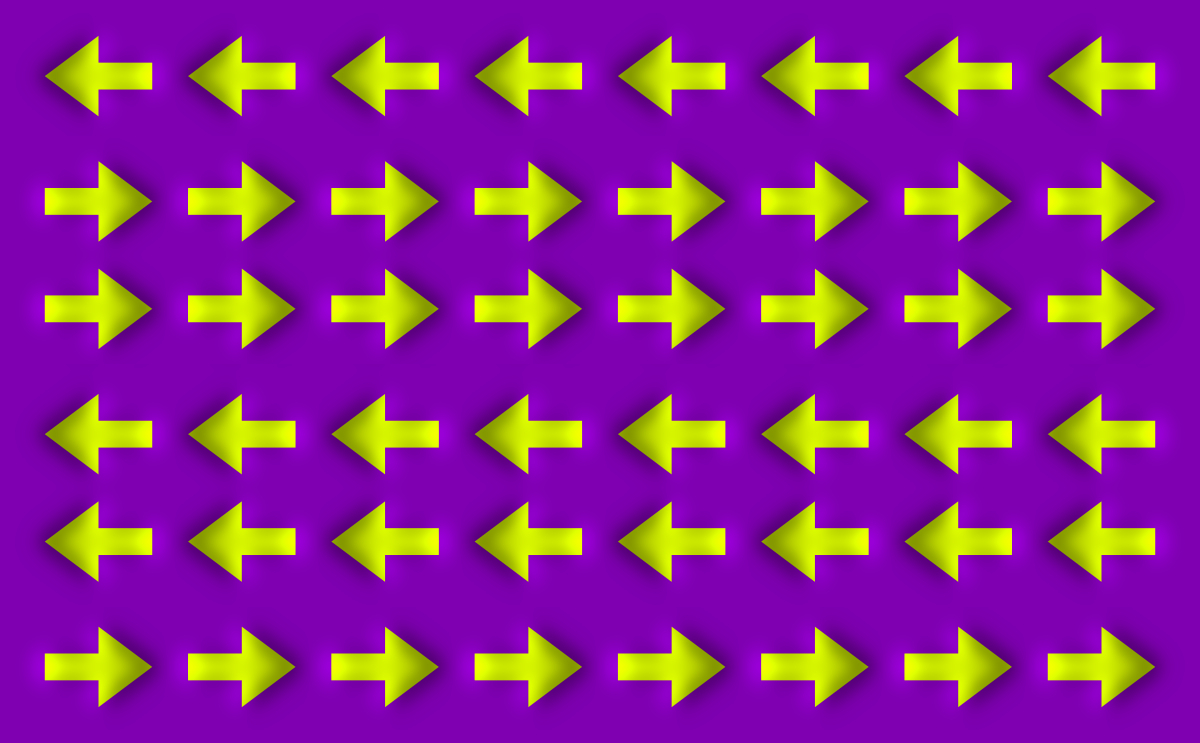
「動く矢印」
矢印が矢印の方向に動いて見える。
Copyright Akiyoshi Kitaoka 2013 (September 26)
問: 下記のような色から、オレンジ色と赤紫色を同時に作る方法はあるか?

答: ある。

Produced Akiyoshi Kitaoka 2012 (September 16)
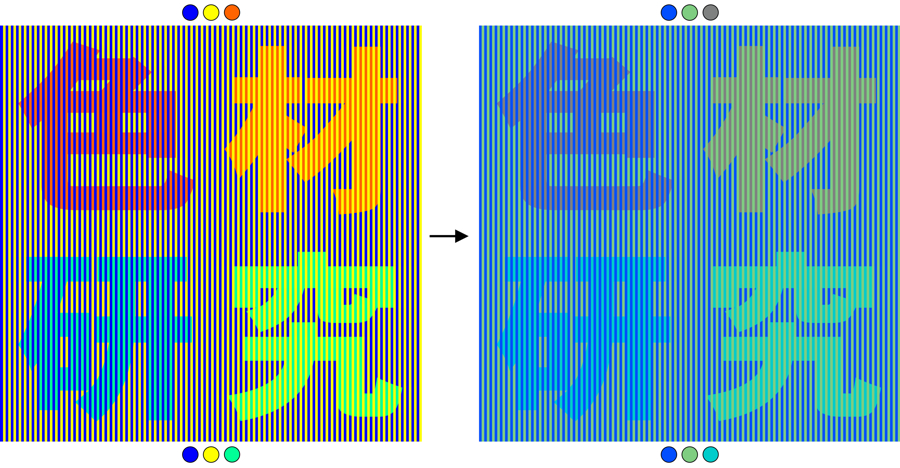
「ムンカー錯視と色の恒常性の色材研究」
左の「色材」は赤が赤紫とオレンジに見え、「研究」は水色と黄緑色に見える。右の「色材」は灰色が赤紫とオレンジに見え、「研究」は青緑色が水色と黄緑色に見える。
Copyright Akiyoshi Kitaoka 2012 (September 16)
色の錯視の色の恒常性図形の作り方
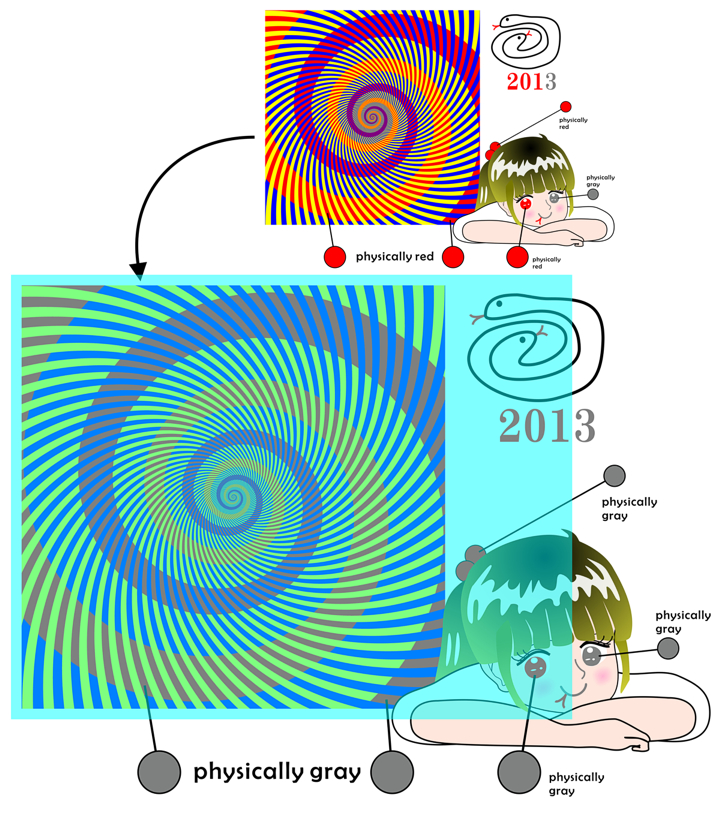
Copyright Akiyoshi Kitaoka 2012 (December 7)
問: お月様と同じ物理的な色をしている円は下の3つのうちどれでしょう。
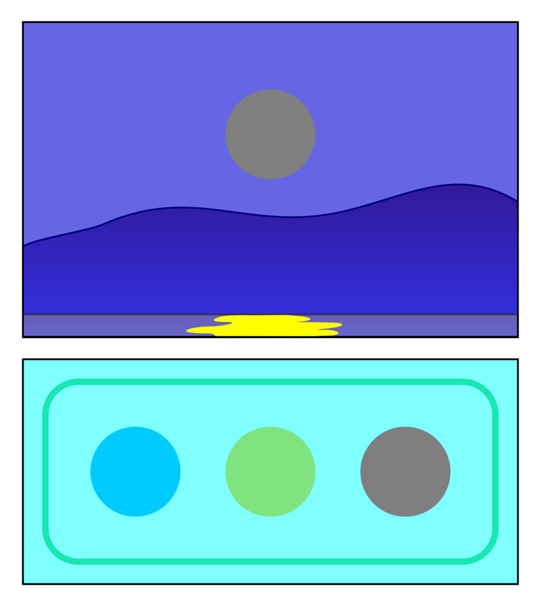
問: 下記のような色から金色を作る方法はあるか?

答: ある。
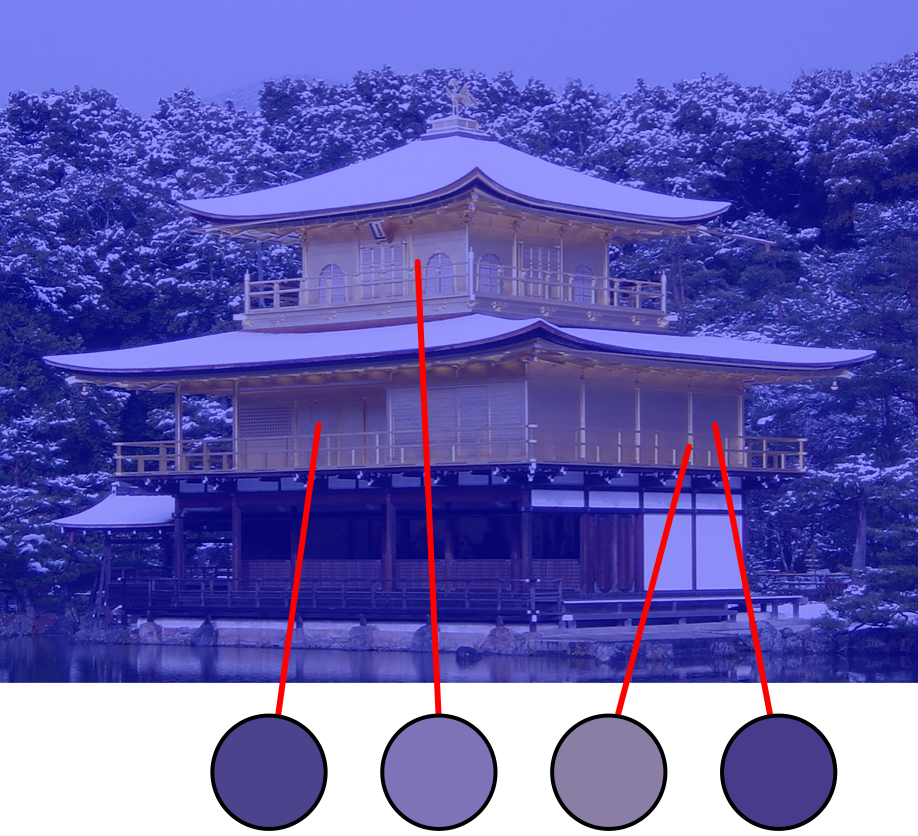
「青い金閣」
青フィルターがかかっていやな感じではあるが金閣は金色に見える。金色は黄色系統でなければならないという前提があるなら、この合成画像で金閣が金色に見えることは錯視であり、知覚される金色は物理的には青系統の色である。
Copyright Akiyoshi Kitaoka 2011 (July 14)
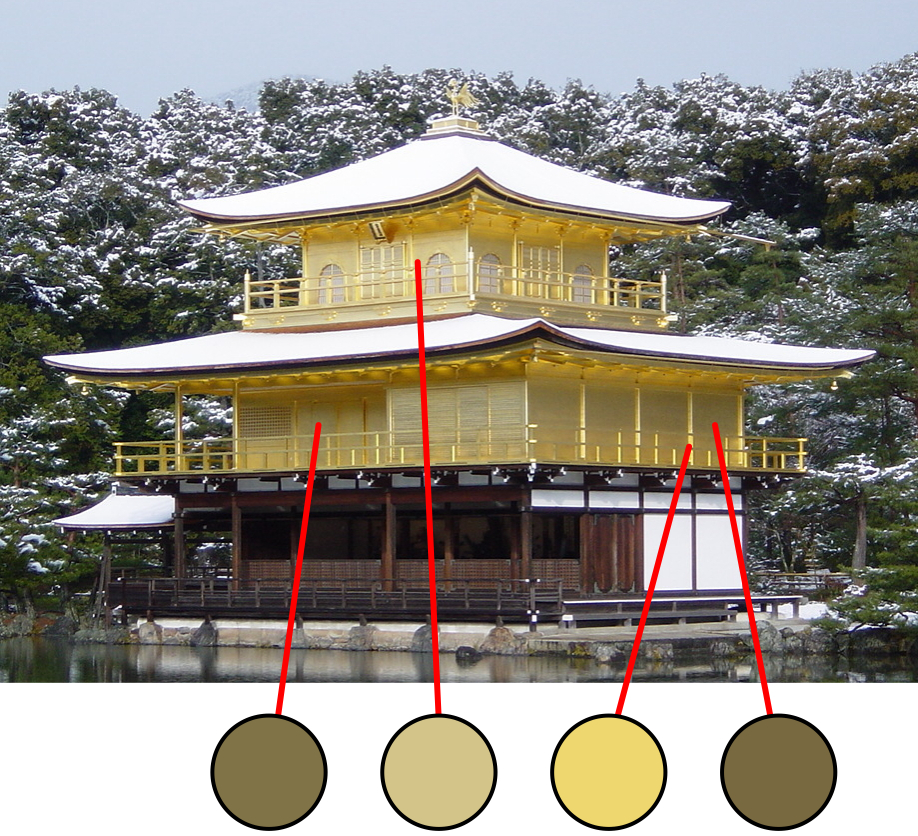
黄色系統でなくても金色に見える。
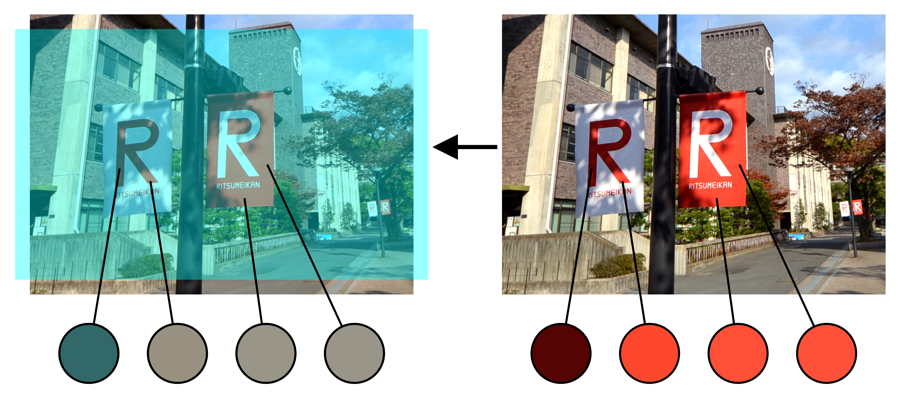
「立命館大学ののぼりの色の恒常性」
Copyright Akiyoshi Kitaoka 2012 (November 30)
色の恒常性錯視デモ用のプリント用ファイル DOC
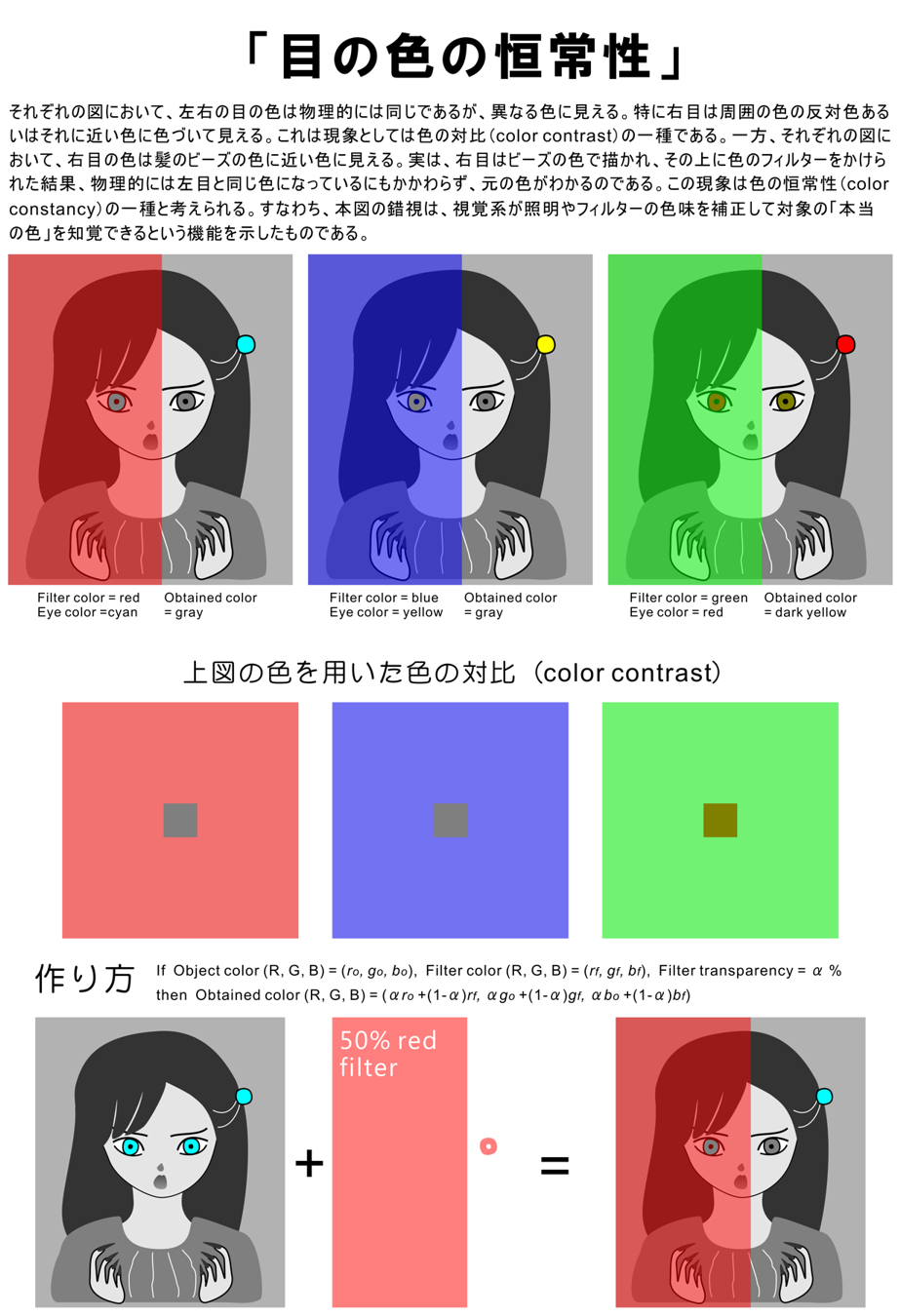
この種の色の恒常性の文献
北岡明佳 (2011) 色の錯視いろいろ (2)色の恒常性と2つの色フィルタ 日本色彩学会誌, 35(3), 234-236. PDF(スキャンコピー), PDF(高解像度スキャンコピー)
北岡明佳 (2011) 色の錯視いろいろ (1)「目の色の恒常性」という錯視の絵 日本色彩学会誌, 35(2), 118-119. PDF(スキャンコピー)
加法的フィルタ
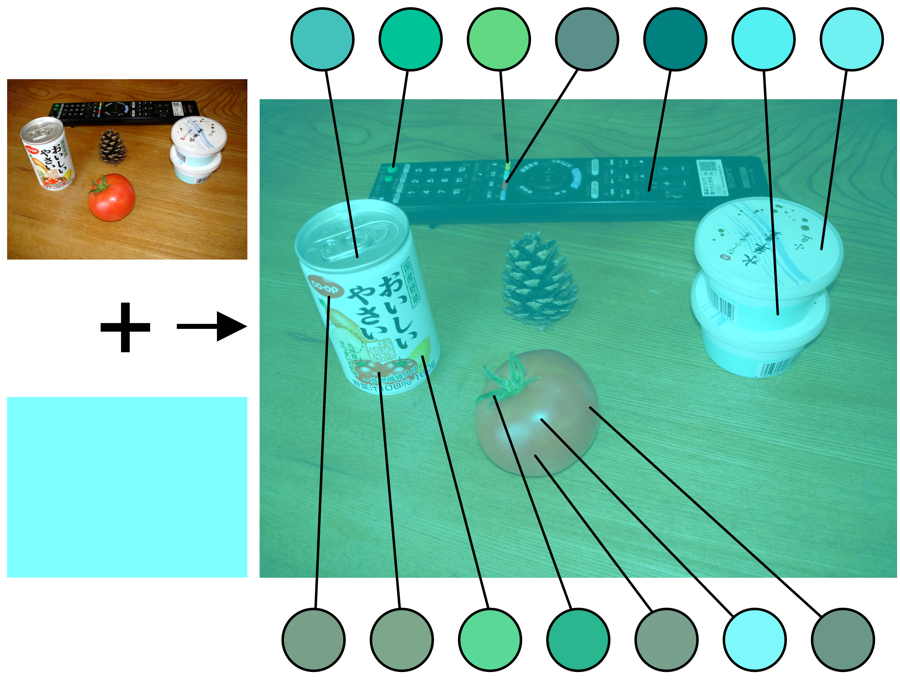
北岡明佳 (2011) 色の錯視いろいろ (2)色の恒常性と2つの色フィルタ 日本色彩学会誌, 35(3), 234-236. <図2>

乗法的フィルタ
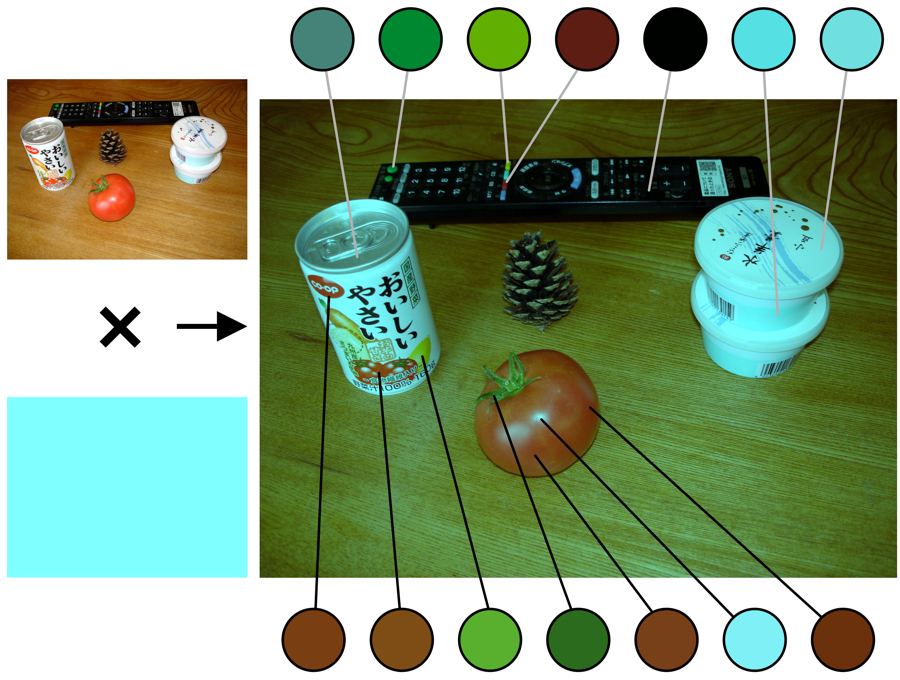
北岡明佳 (2011) 色の錯視いろいろ (2)色の恒常性と2つの色フィルタ 日本色彩学会誌, 35(3), 234-236. <図4>
北岡明佳 (2011) 色の錯視いろいろ (2)色の恒常性と2つの色フィルタ 日本色彩学会誌, 35(3), 234-236. PDF(スキャンコピー), PDF(高解像度スキャンコピー)
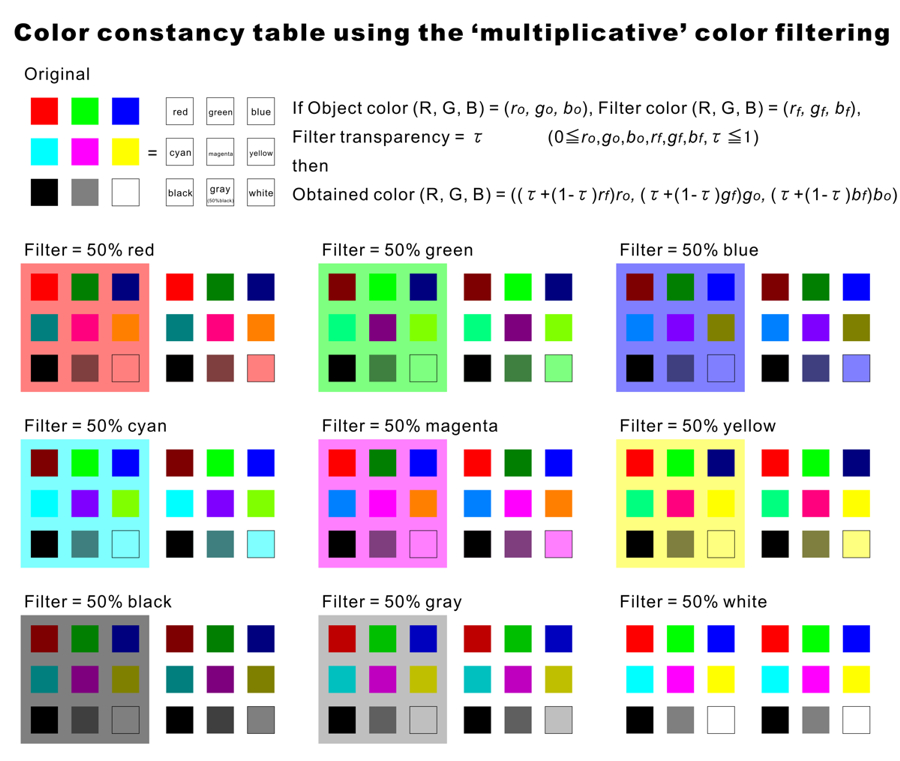
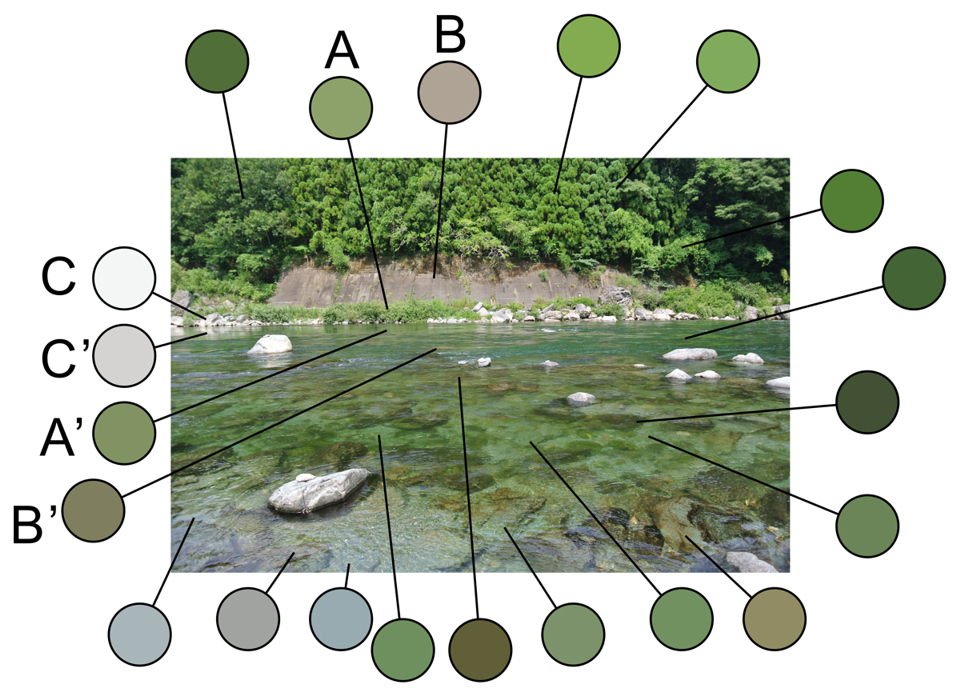
加法的フィルタの例・・・「清流」の緑は山の緑
Copyright Akiyoshi Kitaoka 2013 (August 3)

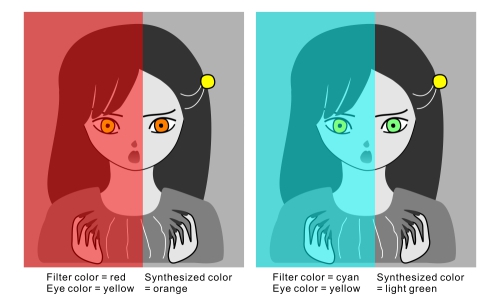
「色の恒常性による両眼闘争の抑制」
2つの図を両眼融合して見ると、左目はオレンジ色と緑色の間の両眼闘争を起こすが、右目は黄色に見えたままである。しかし、右目は左目と同じく、物理的にはオレンジ色と緑色なのである。
Copyright Akiyoshi Kitaoka 2009 (June 29)
色の恒常性は高次な知覚という先入観が私にはあったが、本図は低次処理の証拠となるかもしれない。
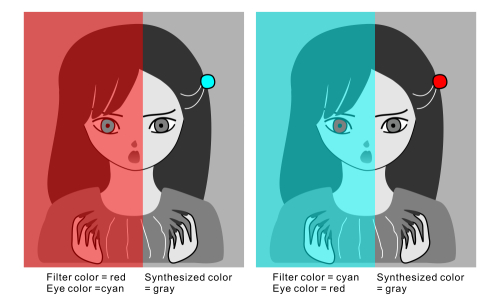
「色の恒常性による両眼闘争」
2つの図を両眼融合して見ると、右目はシアン色(水色)と赤色の間の両眼闘争を起こすことがあるが、左目は灰色に見えたままである。しかし、どちらの右目も左目と同じく、物理的には灰色なのである。
Copyright Akiyoshi Kitaoka 2009 (June 29)
両眼の情報が統合される前に色の恒常性が成立していないと両眼闘争はしないよね・・・その論理でいいのか??
色立体視
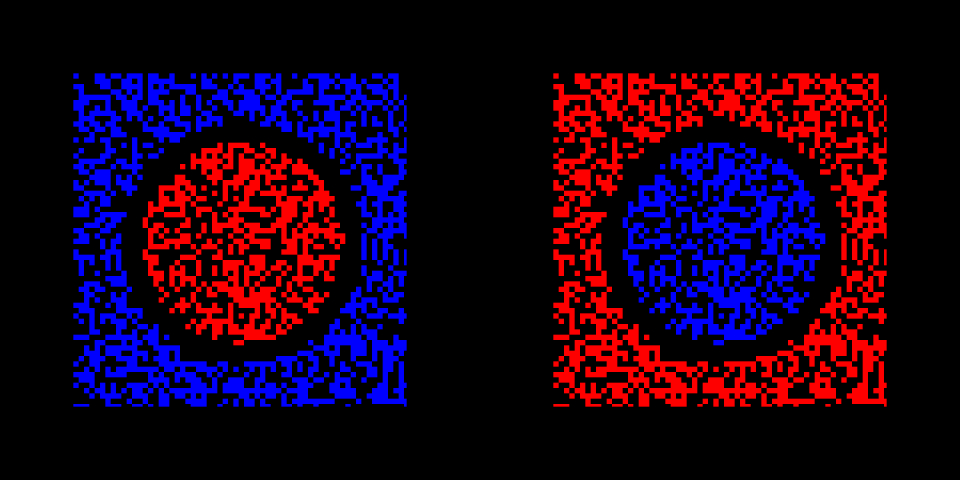
Chromostereopsis
Chromostereopsis. For the majority of observers, the inset made up of red random dots appears to be in front of the surround constituted of blue ones. For a minority, the inset appears to be behind the surround. The rest do not experience the phenomenon. Chromostereopsis is strong when observers see the image at a distance.
Copyright Akiyoshi Kitaoka 2013 (August 3)
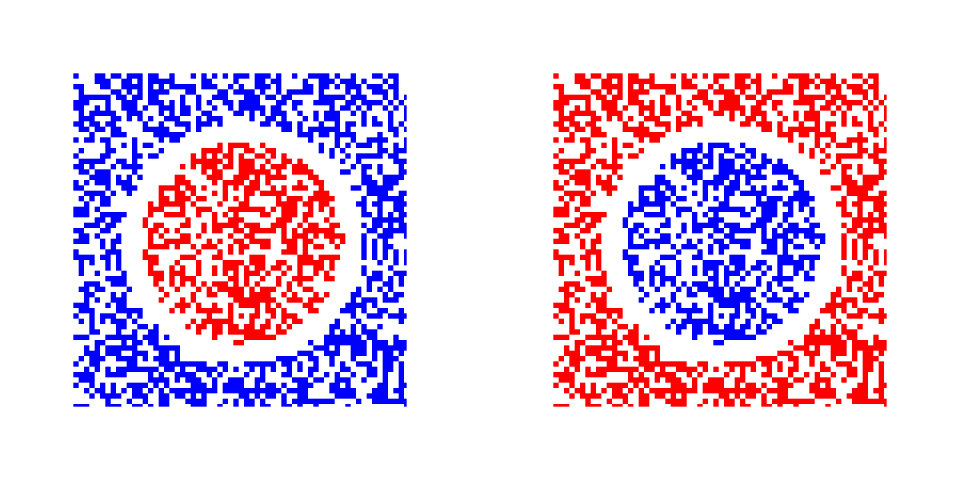
Background luminance-dependent reversal; color reversal
Copyright Akiyoshi Kitaoka 2013 (August 3)
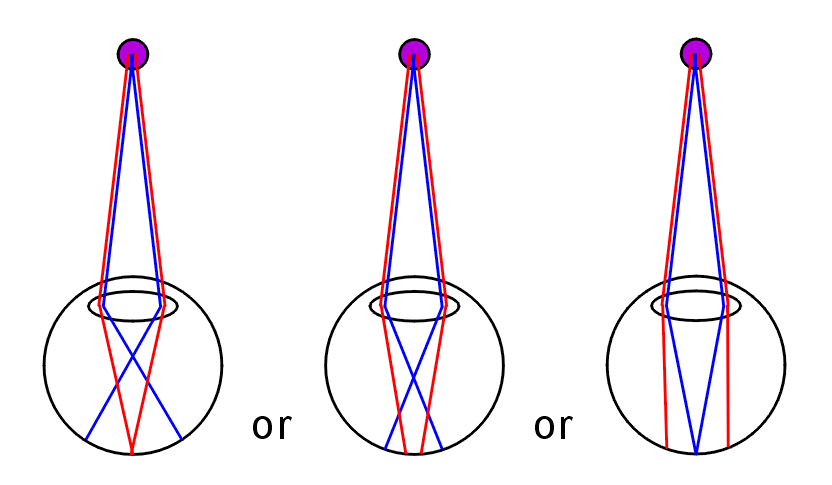
Longitudinal chromatic aberration
Copyright Akiyoshi Kitaoka 2005 (November 24)
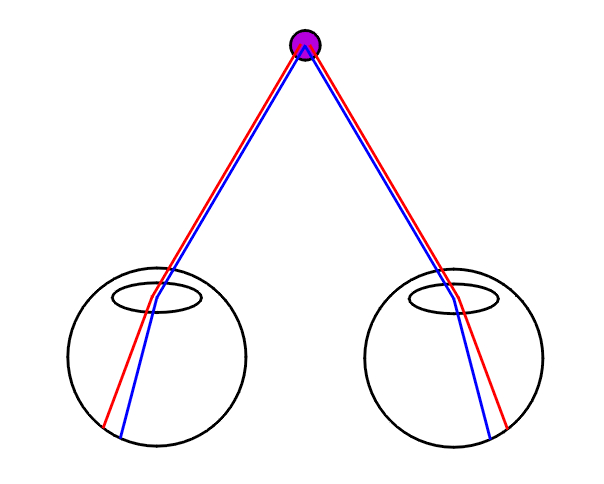
Transverse chromatic aberration
Copyright Akiyoshi Kitaoka 2005 (November 24)
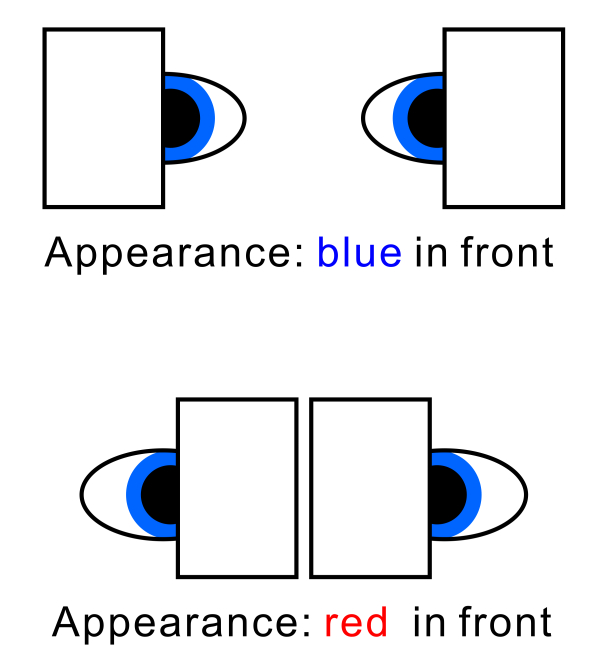
Einthoven's (1885) covering method
Copyright Akiyoshi Kitaoka 2009 (February 29)
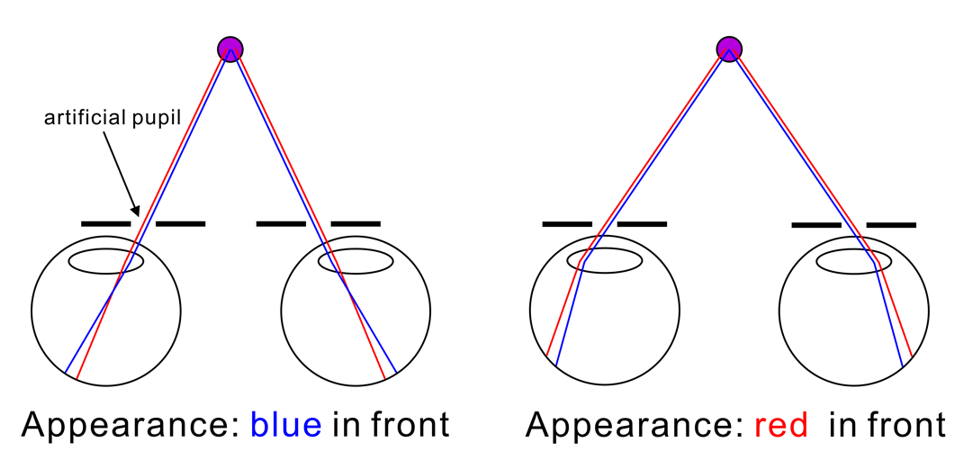
Artificial pupil method & Stiles-Crawford effect
---> Vos' (1960, 2008) "generalised Bruecke-Einthoven explanation"
Copyright Akiyoshi Kitaoka 2009 (February 29)
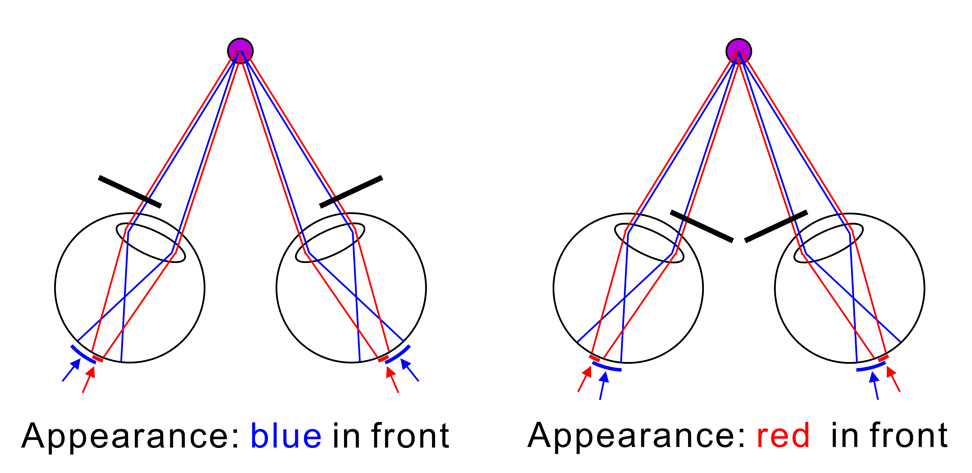
Center-of-gravity model (Kitaoka et al., 2005)
Copyright Akiyoshi Kitaoka 2013 (July 25)
Kitaoka, A, Kuriki, I. and Ashida, H. (2006). The center-of-gravity model of chromostereopsis. Ritsumeikan Journal of Human Sciences, 11, 59-64. PDF
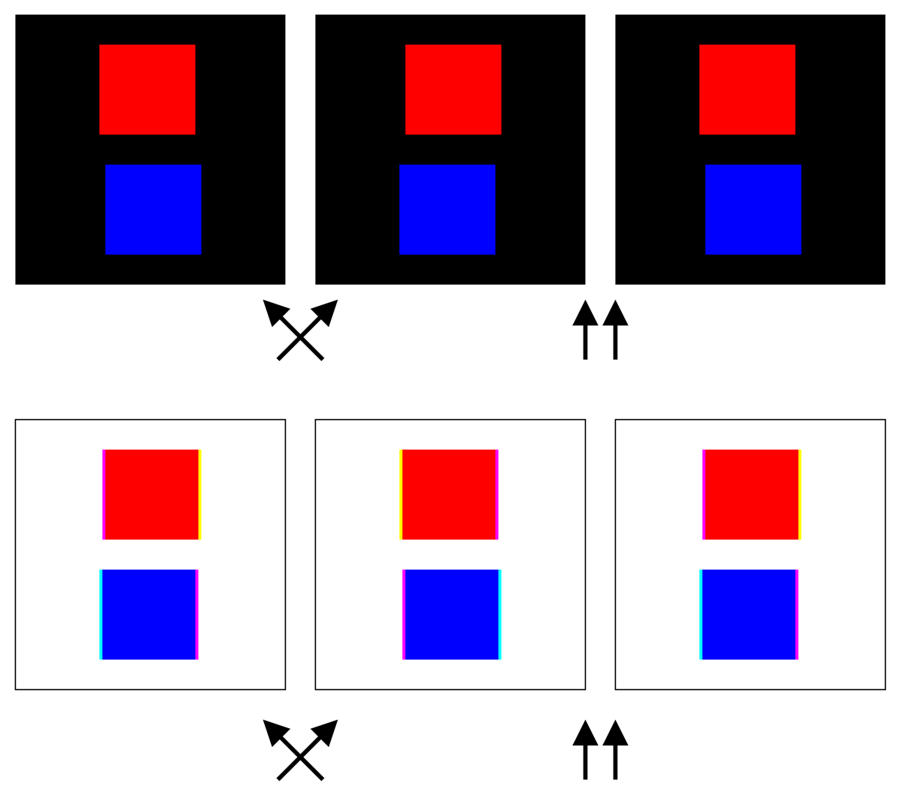
Kitaoka's explanation of the background luminance-dependent reversal
Copyright Akiyoshi Kitaoka 2013 (July 25)
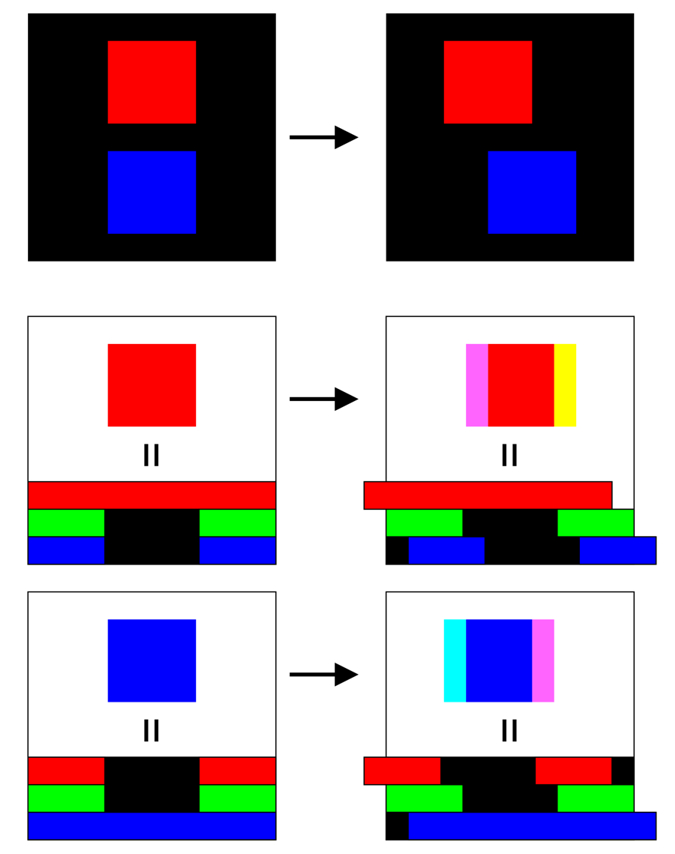
透明に見える山
山が透明に見える。

手前の山は「筆ノ山」(ふでのやま)、奥の山は「我拝師山」(がはいしやま、がはいしざん)と思われる。
Copyright Akiyoshi Kitaoka 2013 (August 1) 香川県善通寺市・高松自動車道善通寺インターチェンジ付近にて。撮影日は 2013年7月31日(水)

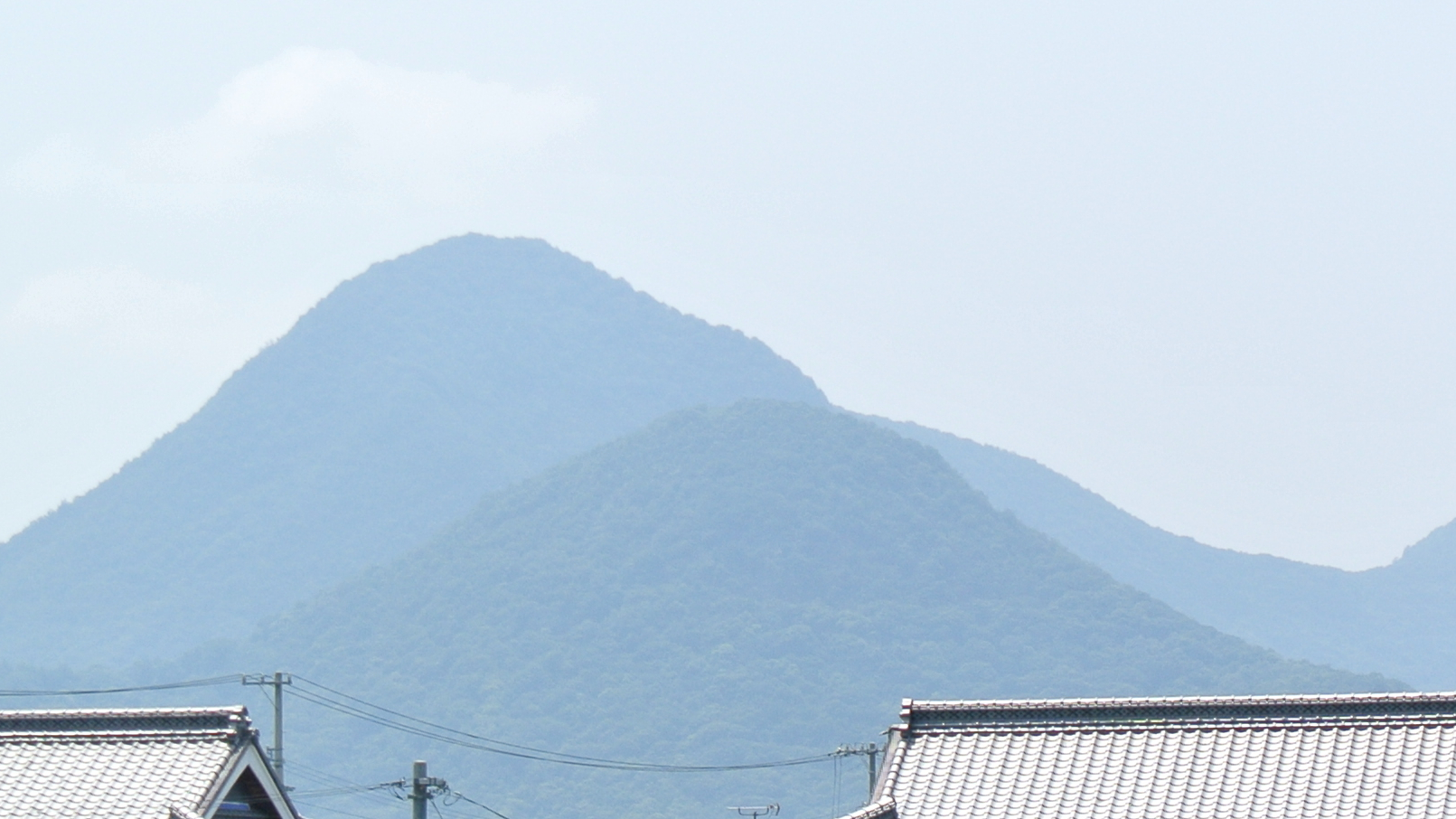
拡大するとバレバレ

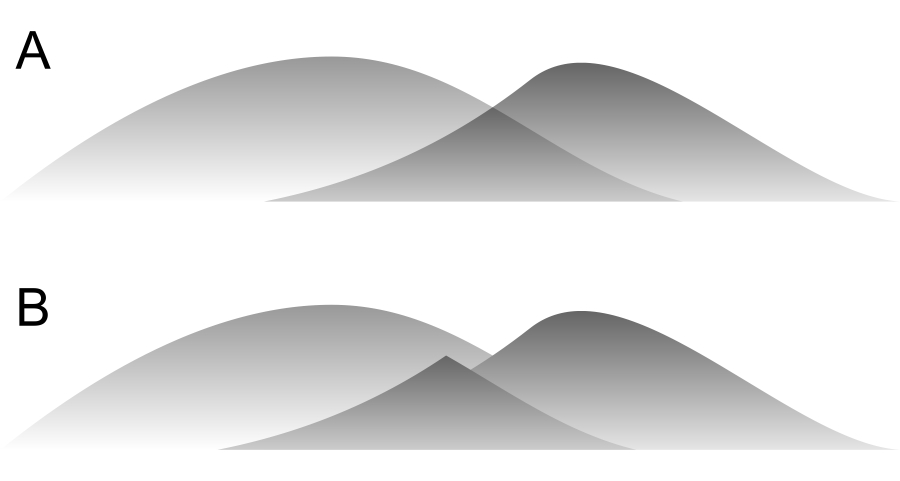
北岡明佳のコメント: Adelson-Anandan-Andersonのモデルで言えば、bistable transparency (両義的透明視あるいは二値安定透明視あるいは反転可能透明視)である。
なお、「透明に見える山」の報告はこれが初めてではなく、池田(1993)(関西大学『社会学部紀要』第25巻第1号pp.165-168)によると、大阪府吹田市の一角から遠望した山に見えるとして、写真が載っている。その池田によると、Metzger (1953) に既に載っている。
透明視については、以下を参照されたい。
透明視講義用のプリント
Kitaoka, A. (2005) A new explanation of perceptual transparency connecting the X-junction contrast-polarity model with the luminance-based arithmetic model. Japanese Psychological Research, 47, 175-187. PDF
関連した錯視写真
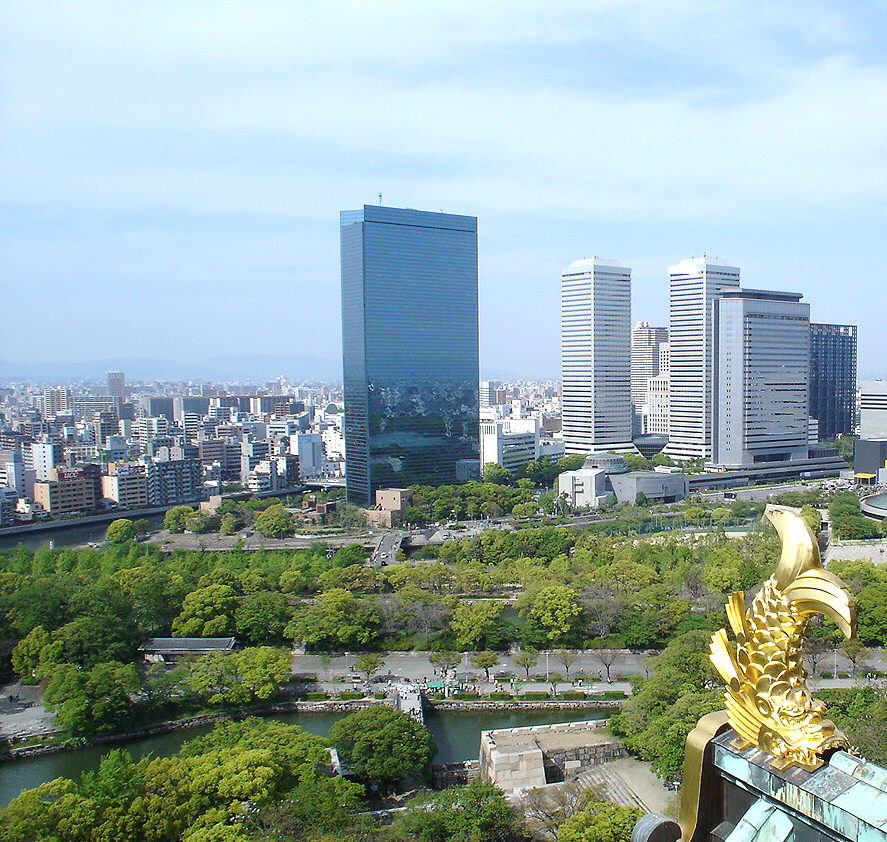
「透明に見えるビル」
中央のビル(クリスタルタワー)が透明に見える。
Copyright Akiyoshi Kitaoka 2007 (May 1)
大阪城の天守閣からの眺めなので、いつでも見ることができる。大阪城にはエレベーターがあるので、登るのは楽である。なお天守閣は8階が最上階であるが、エレベーターは5階までである。なぜ途中までかというと、「大阪夏の陣の後、徳川家が再建した当時の技術では、エレベーターは5階までが限界だったから」と言っている人がいた。(オレや)
渦巻き錯視
同心円が渦巻きに見える。
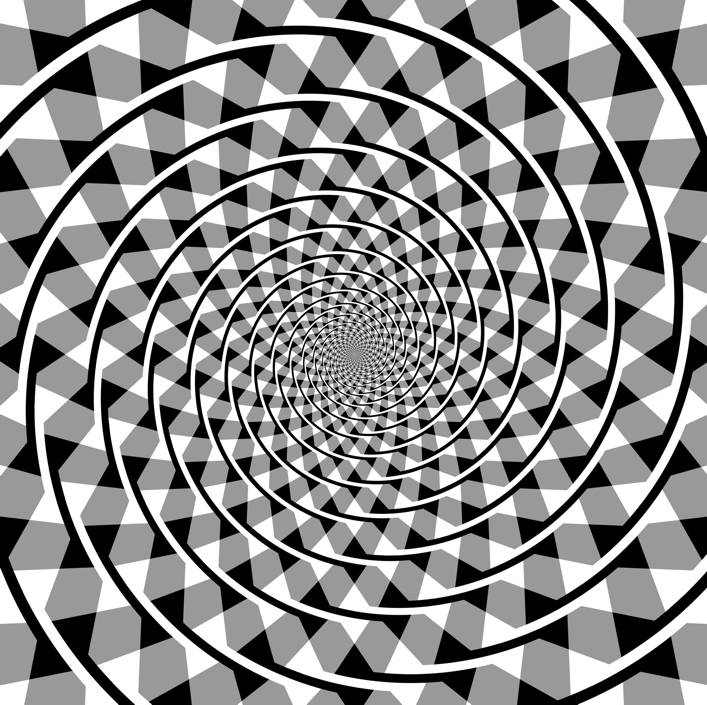
Fraser's spiral
The term "spiral illusion" had long referred to the spiral illusion of the Fraser illusion (Fraser, 1908) before we elucidated that any tilt illusion can form spiral illusion (Kitaoka, Pinna and Brelstaff, 2001). This page shows a copy of Fraser's spiral produced by PC programming. <2003/8/30>
Fraser, J. (1908) A new visual illusion of direction. British Journal of Psychology, 2, 307-320.
Kitaoka, A., Pinna, B., and Brelstaff, G. (2001). New variations of spiral illusions. Perception, 30, 637-646. PDF
Catalogue of spiral illusions (in Japanese) (配布物)
北岡明佳 (2006) 渦巻き錯視のメカニズム じっきょう数学資料, 52, 13-15. PDF
"Spiral blood vessel"
Red concentric rings appear to be spirals.
Copyright Akiyoshi Kitaoka 2007 (June 26)
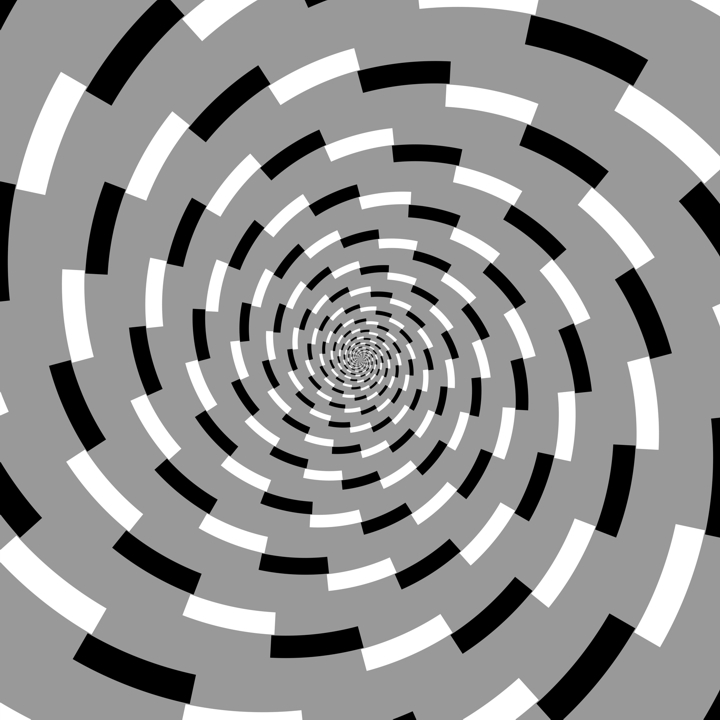
Simple version of the spiral illusion of the Fraser illusion
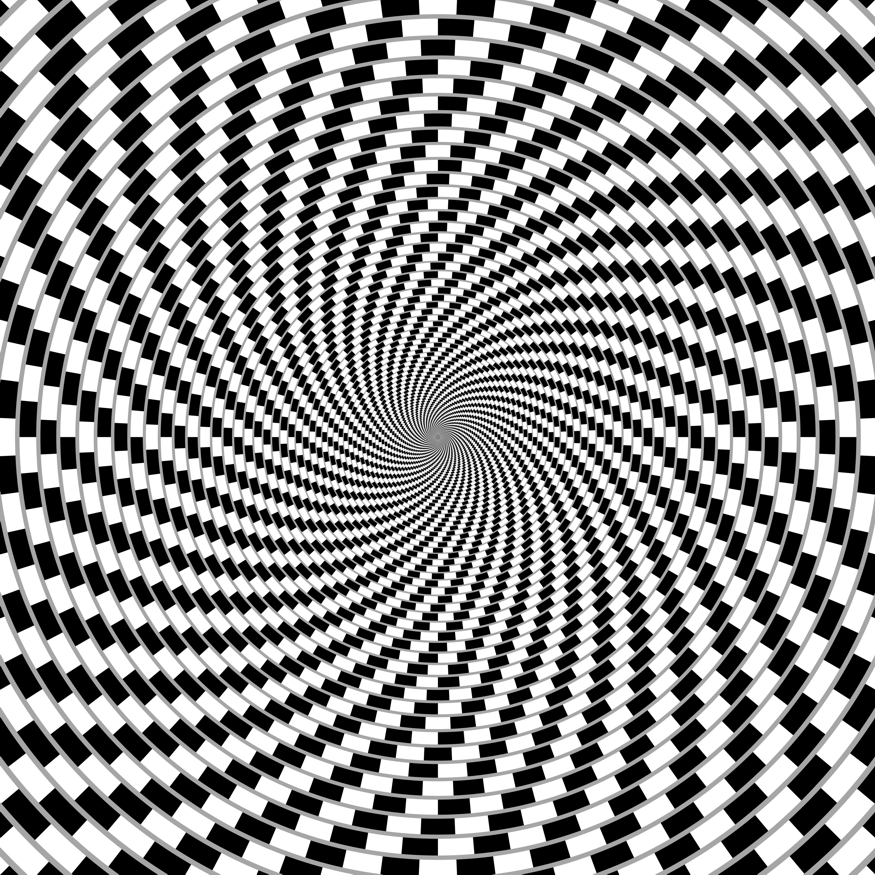
Spiral illusion of the Cafe Wall illusion

"Songs of
frogs"
(a remake)
Concentric arrays of dots appear to be spirals.
Copyright Akiyoshi Kitaoka 2008 (January 2008)
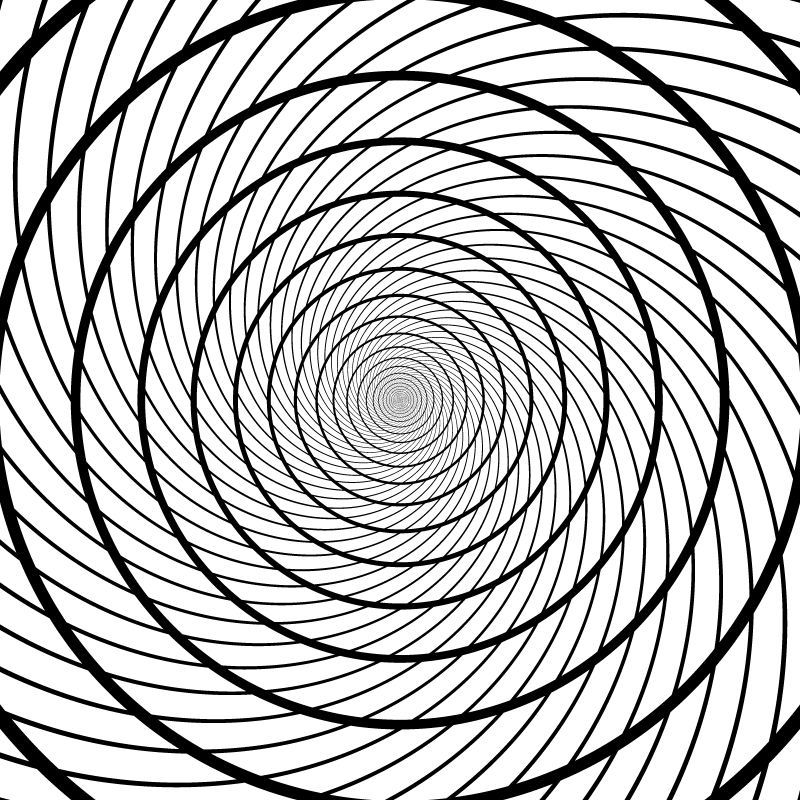
Spiral illusion of the Zöllner illusion
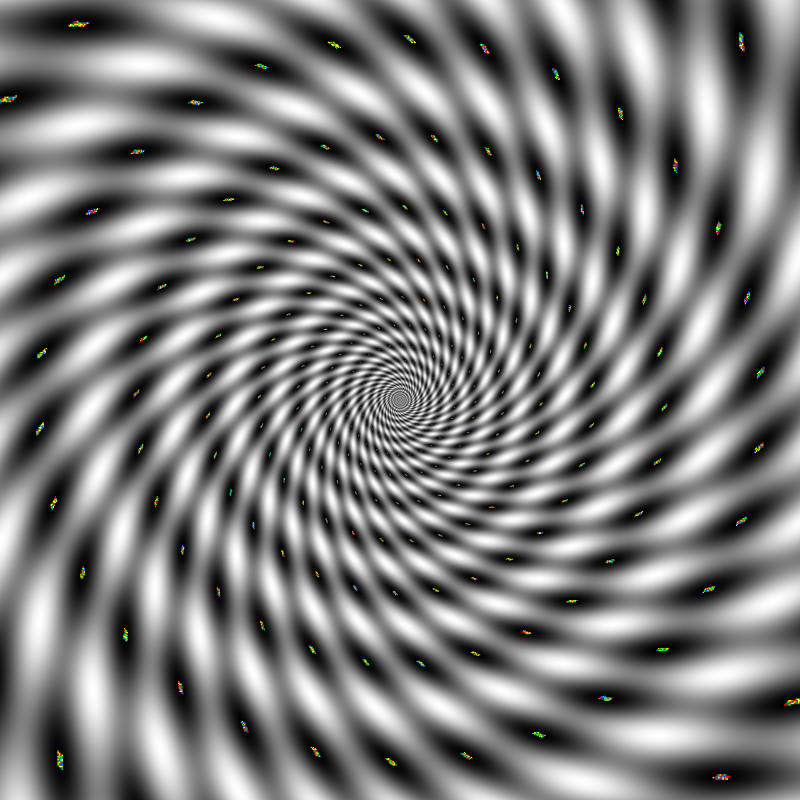
"Spiral warp"
Concentric rings appear to be spirals.
Copyright Akiyoshi Kitaoka 2007 (June 29)
equiangle = 45 deg
The spiral illusion of the Zöllner illusion:
Kitaoka, A., Pinna, B., and Brelstaff, G. (2001). New variations of spiral illusions. Perception, 30, 637-646.
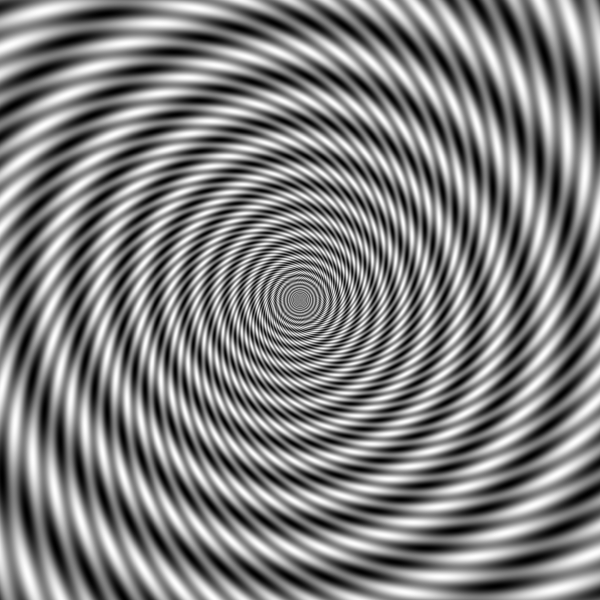
Spiral illusion of the Zöllner illusion
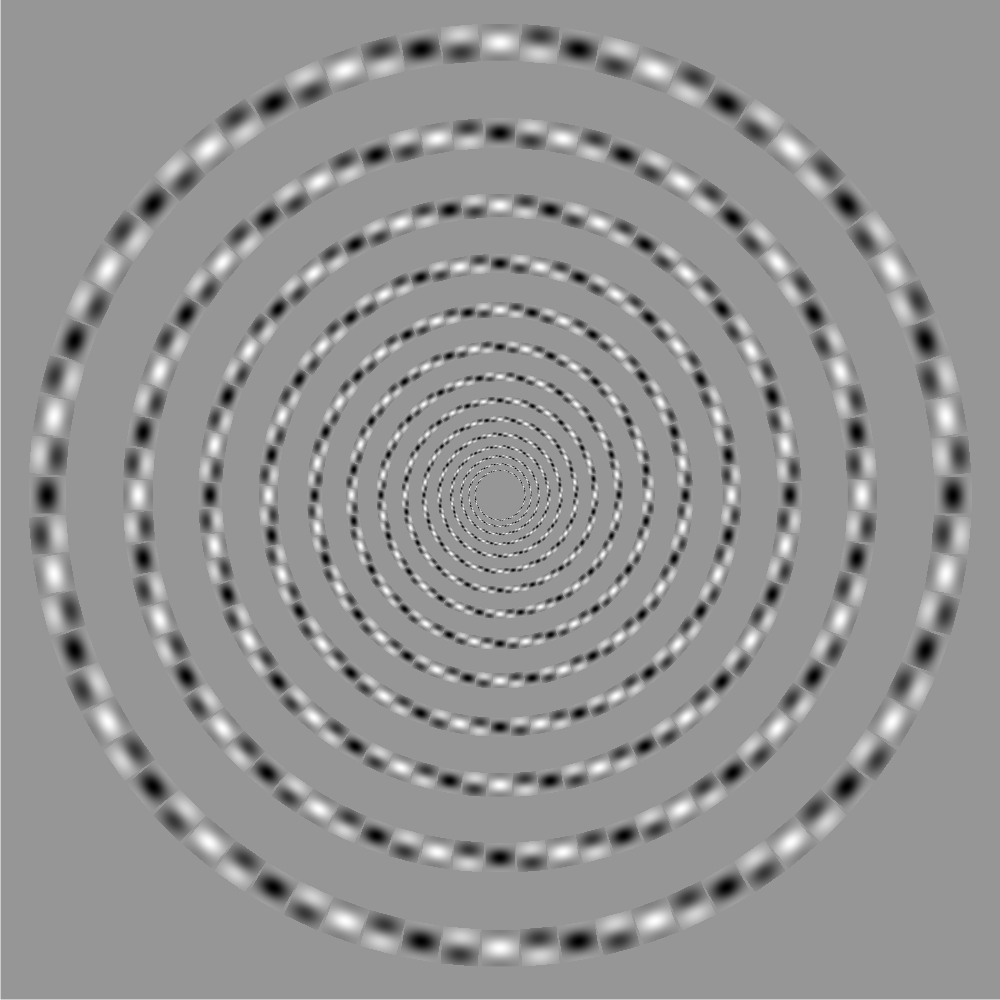
Spiral illusion of the Popple illusion
Copyright Akiyoshi Kitaoka 2007 (August 29)
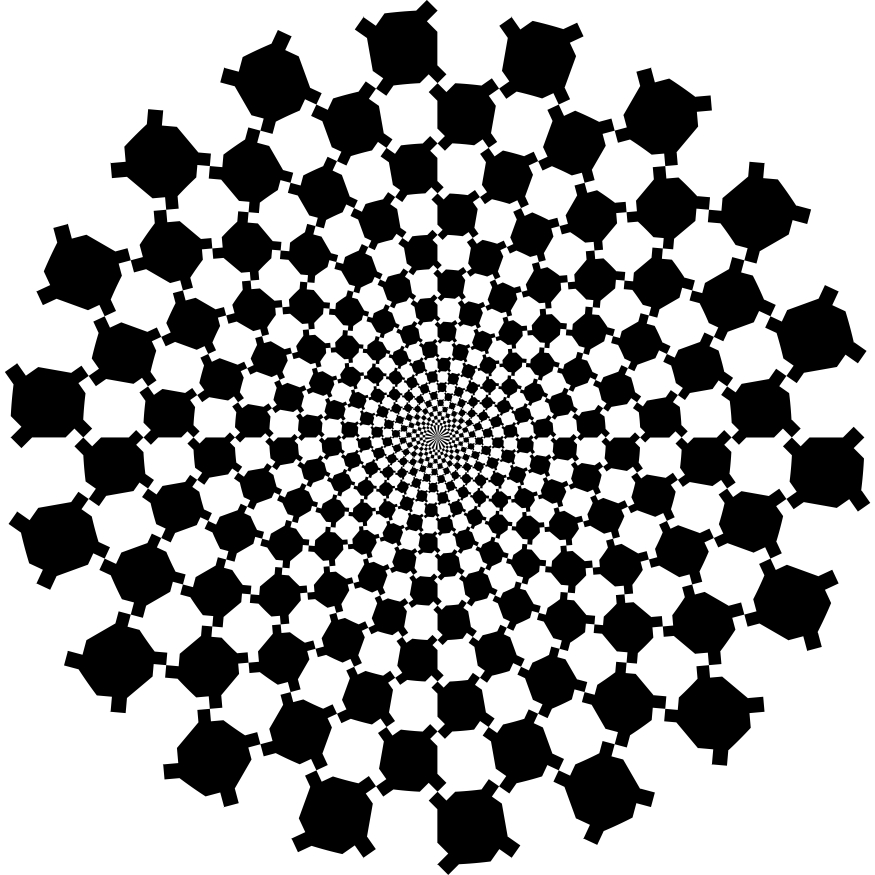
Spiral illusion of the illusion of fringed edges
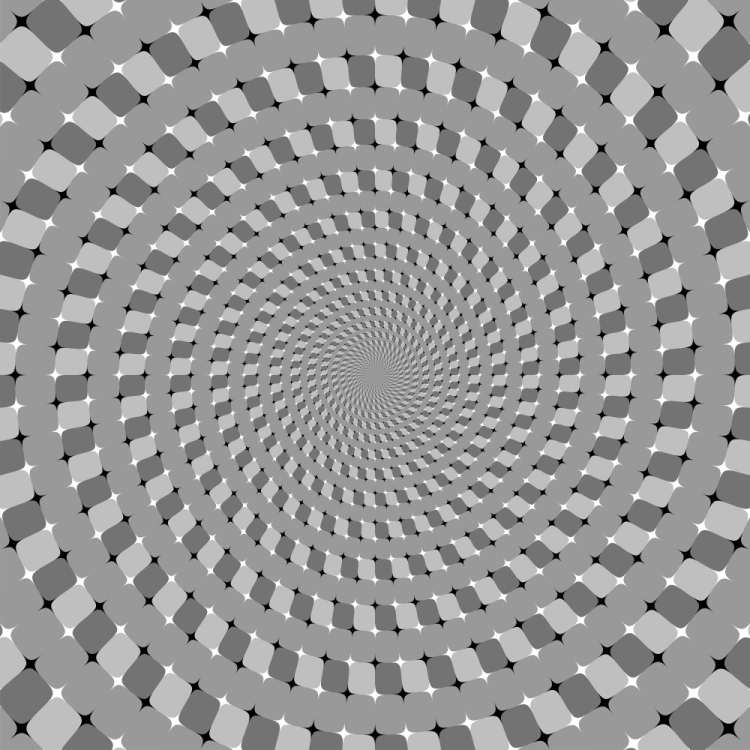
Spiral illusion of the illusion of Y-junctions
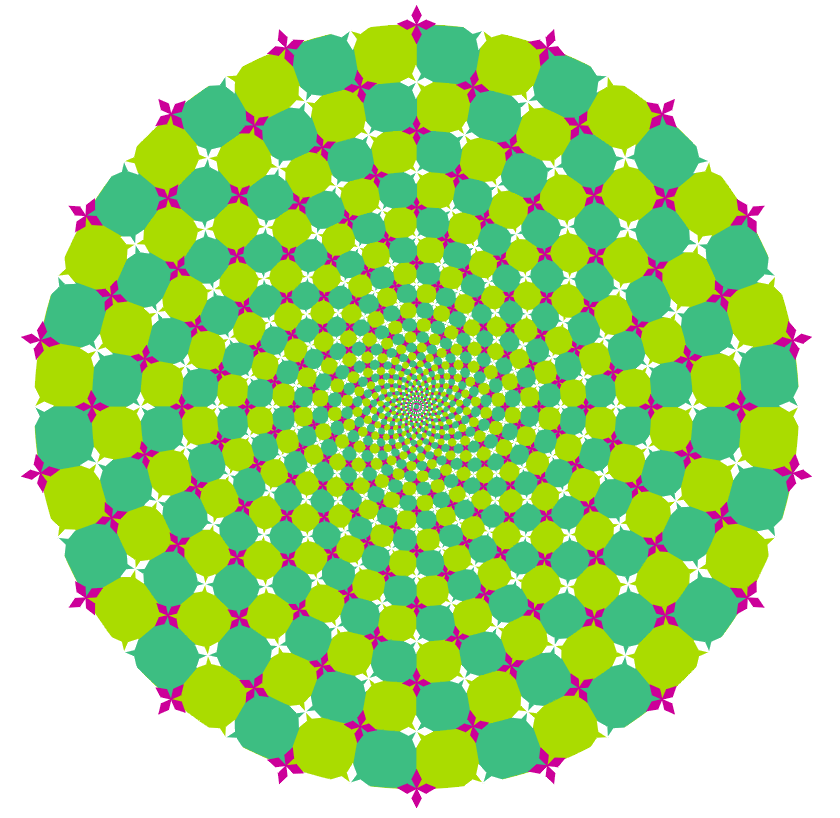
"Primrose's spirals"
Concentric arrays of "flowers" appear to be spirals.
Copyright A.Kitaoka 2002
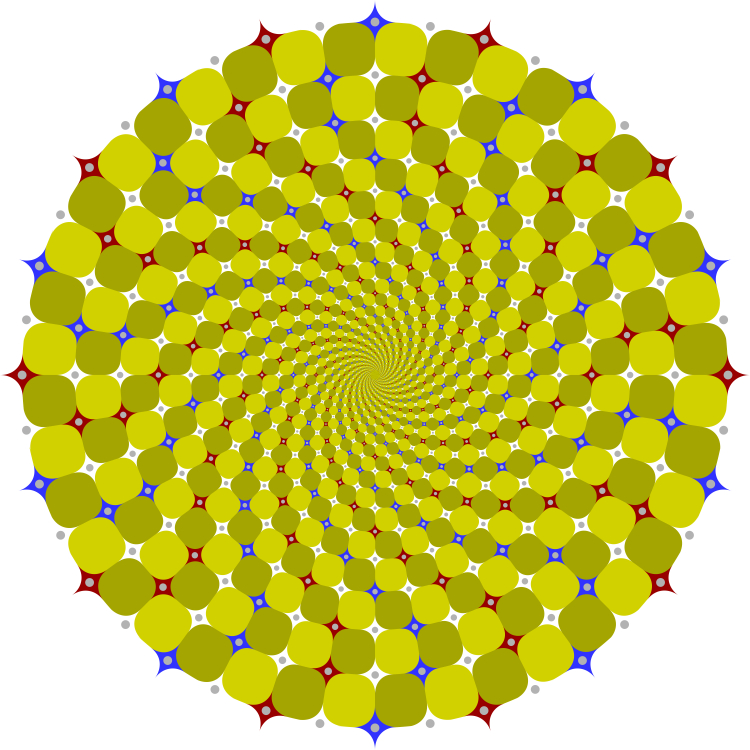
"Neural circuit spirals 2"
Concentric circles appear to be spirals (going to the center by rotating clockwise). Moreover, the inner part appears to rotate clockwise (counterclockwise) when observers approach (move away from) the image keeping their eyes fixed at the center.
Copyright Akiyoshi Kitaoka 2007 (August 7)
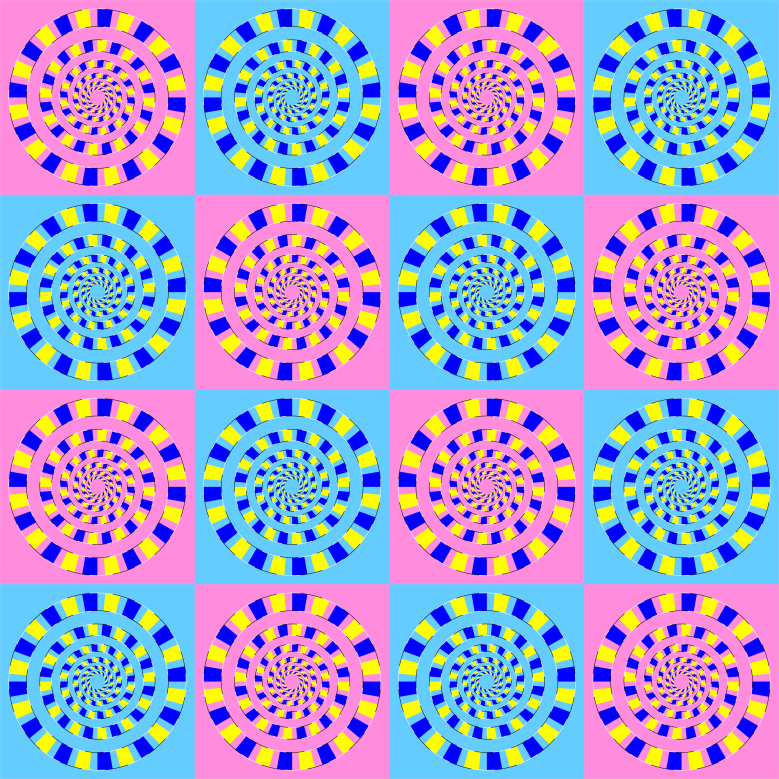
"Packed spirals"
Concentric rings appear to be spirals. Moreover, each set of rings appears to rotate.
Copyright Akiyoshi Kitaoka 2006 (June 13)
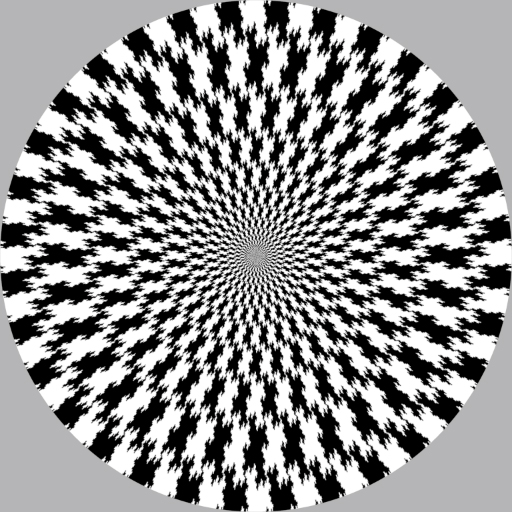
"Fractal spiral illusion"
Concentric rings made up of fractal islands appear to form spirals.
Copyright Hitoshi & Shinobu Arai
2007
from Professor Hitoshi Arai,
Graduate School of Mathematical Sciences, University of Tokyo, October 4,
2007
北岡明佳のコメント: 原理としてはフレーザー錯視のようですが、それよりもなによりも、世界初のフラクタル錯視図形 なのではないでしょうか!? 新井先生の視覚数学e研究室報告に、この錯視の論文が出ました。 <2007年10月4日>
 Suggested function
Suggested function
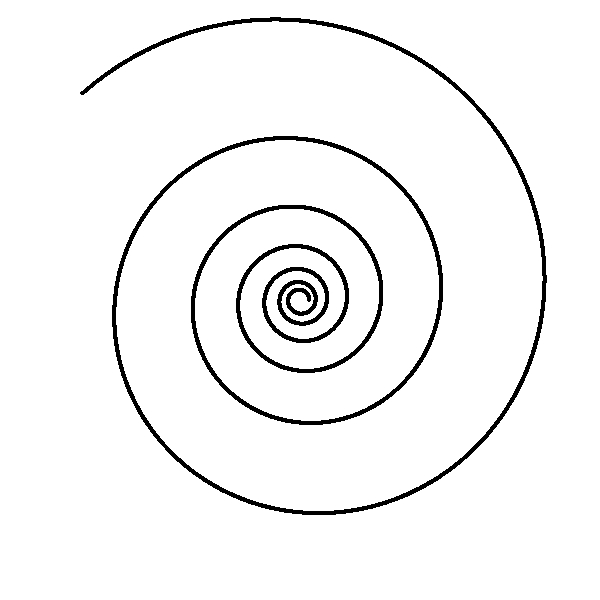
Bernoulli's spiral
r = a exp (k θ)
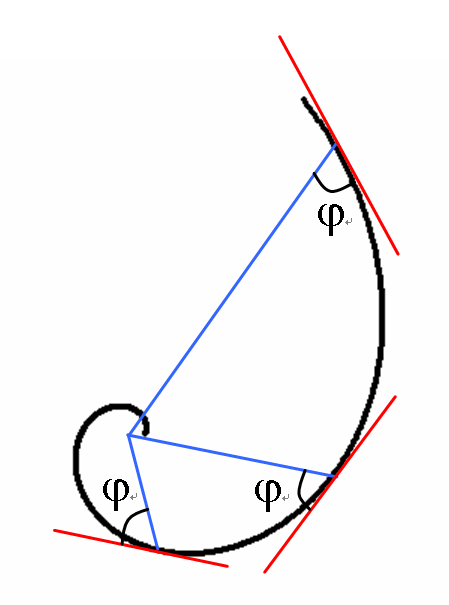
= equiangular spiral
k = 1 / tan (φ)
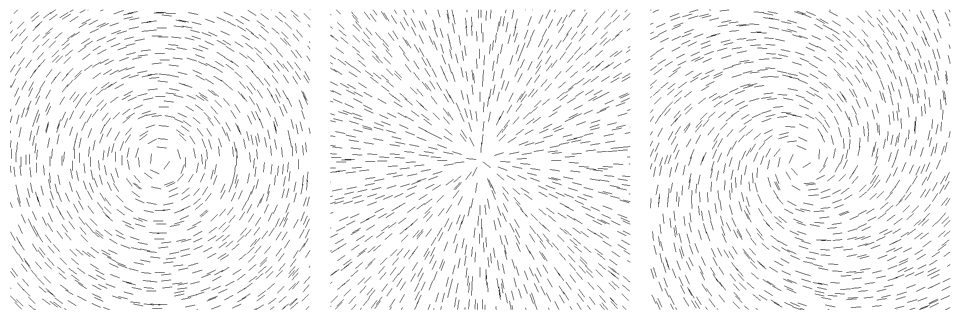
Concentric (φ = 90º), radial (φ = 0º), and spiral (0º < φ < 90º)
Kitaoka, A., Pinna, B., and Brelstaff, G. (2001). New variations of spiral illusions. Perception, 30, 637-646. PDF
フレーザー・ウィルコックス錯視群
繰り返しパターンに沿って動いて見える錯視
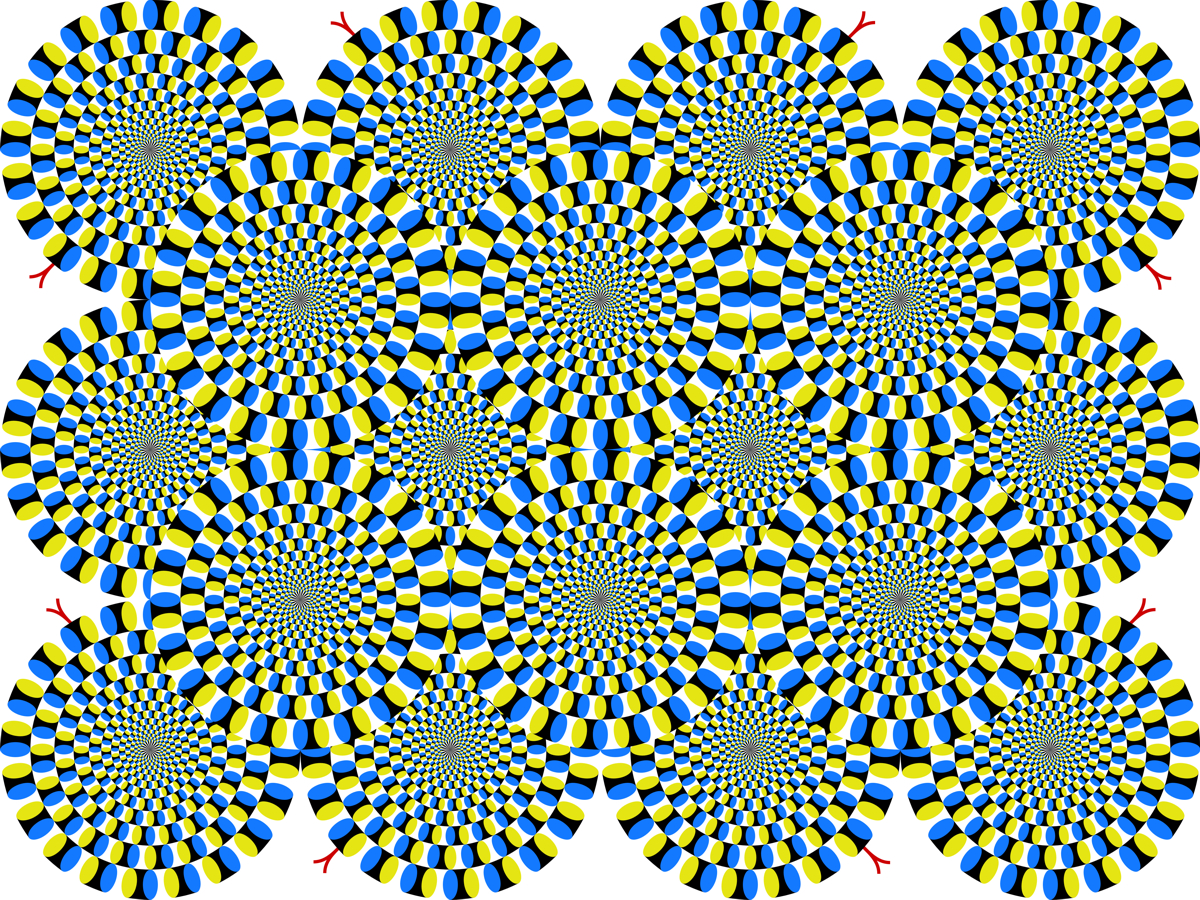
「蛇の回転」
(リメーク)
Copyright Akiyoshi Kitaoka 2013 (February 16)
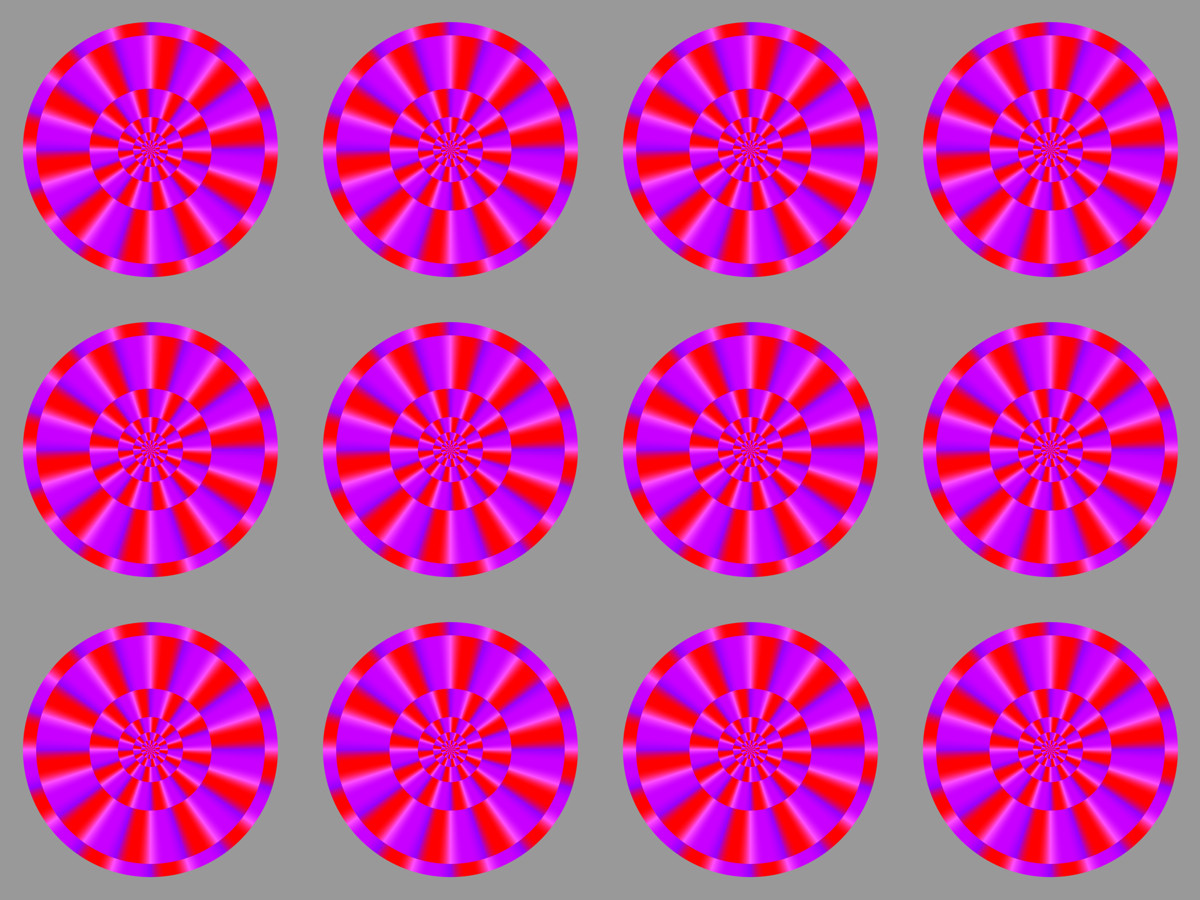
"Rotating red-and-purple disks"
Each disk appears to rotate clockwise on a bright display, while it appears to rotate counterclockwise with a printed image under dark illumination.
Copyright Akiyoshi Kitaoka 2013 (February 6)
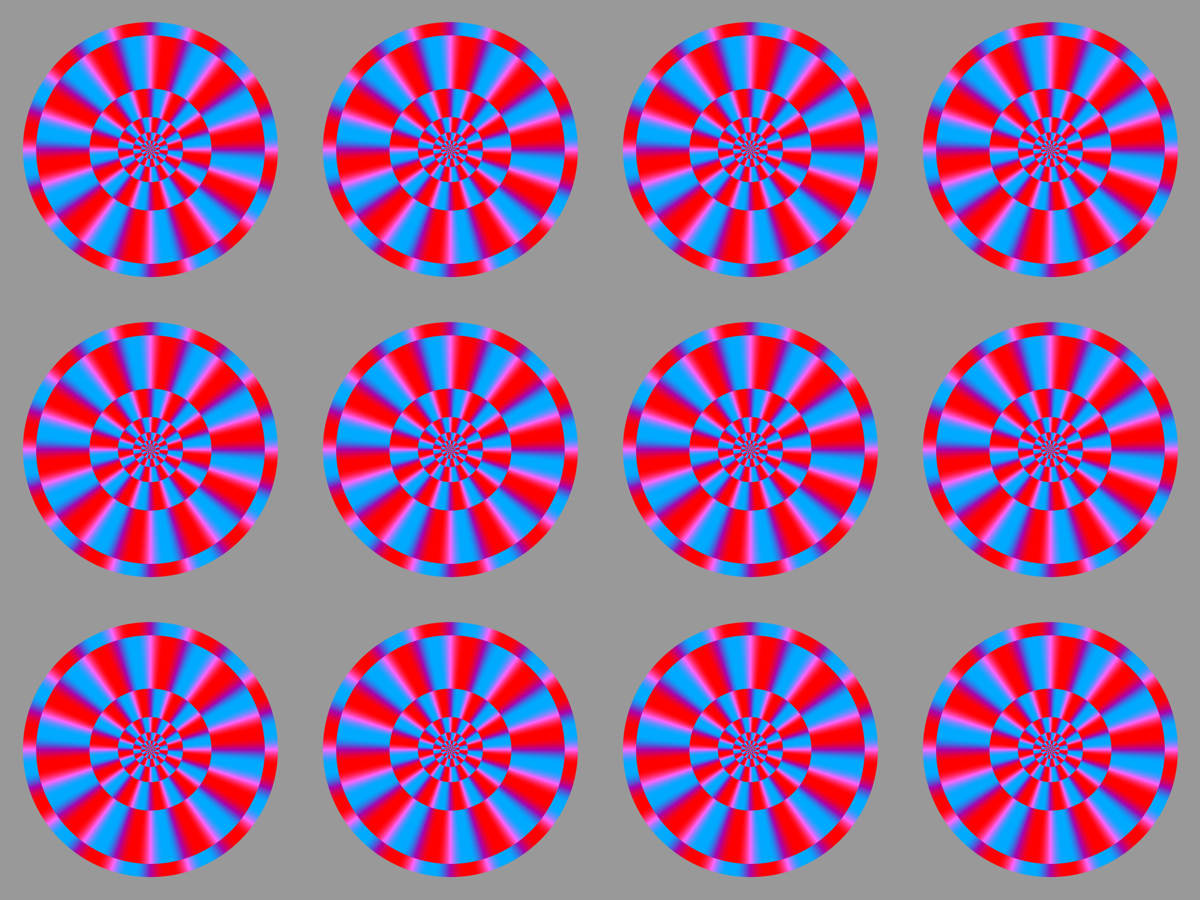
"Rotating red-and-cyan disks 2"
Each disk appears to rotate clockwise on a bright display, while it appears to rotate counterclockwise with a printed image under dark illumination.
Copyright Akiyoshi Kitaoka 2013 (February 6)
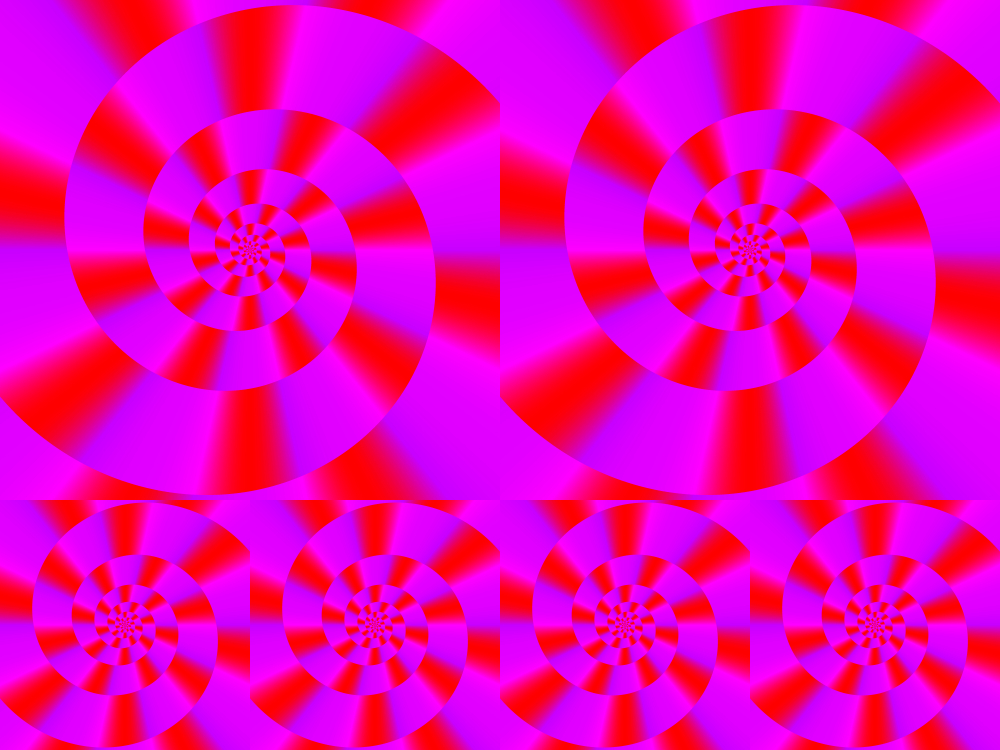
"Takonyudo"
takonyudo = octopus
Each disk appears to rotate counterclockwise when this image is presented on a bright PC display or in a print with a bright environment.
Copyright Akiyoshi Kitaoka 2009 (January 11)
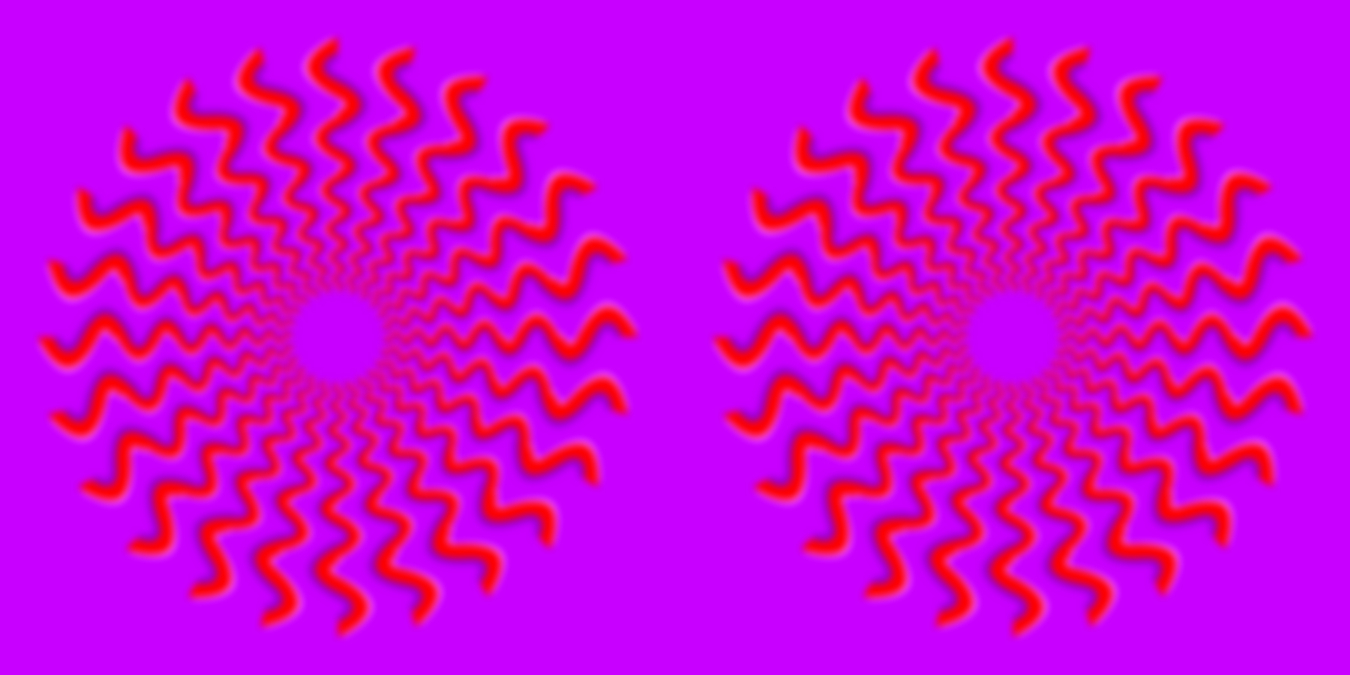
"Fudo-myo-o 2012"
Each disk appears to rotate clockwise when this image is presented on a bright PC display or in a print with a bright environment.
Copyright Akiyoshi Kitaoka 2012 (December 3)
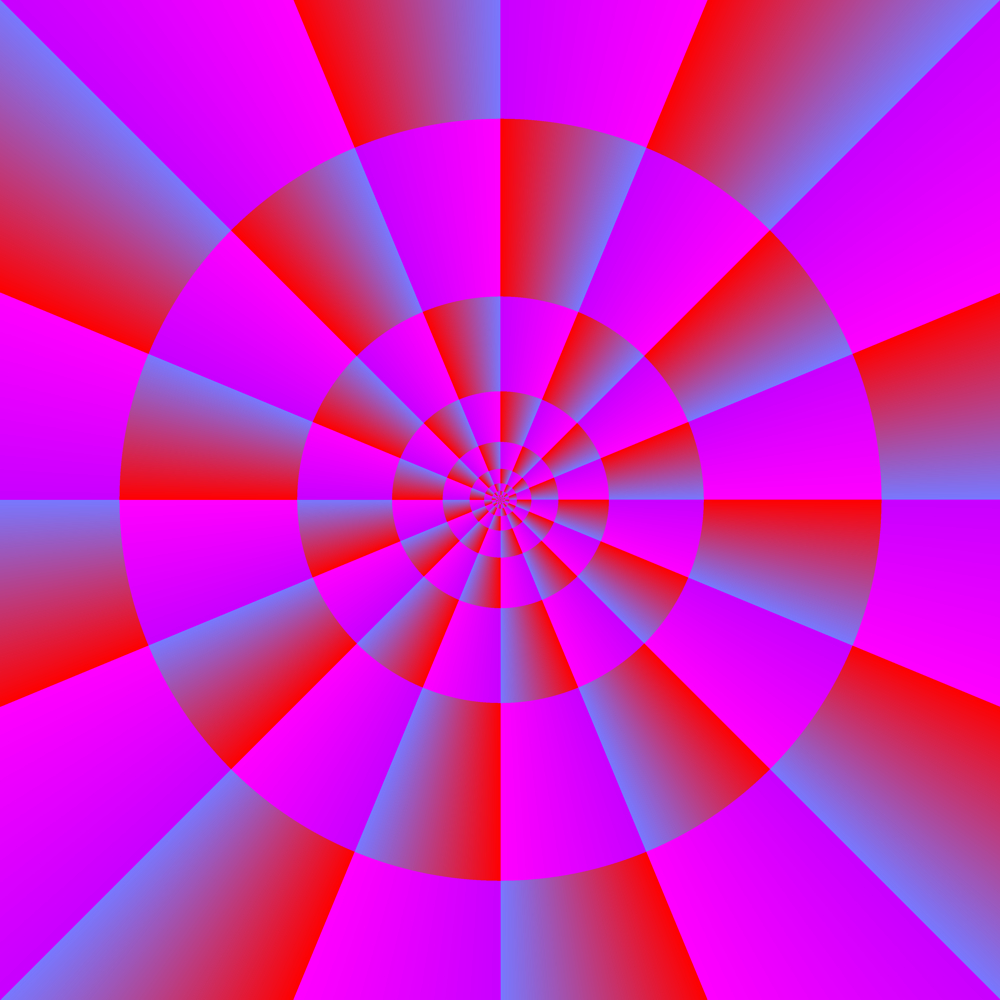
The disk appears to rotate clockwise when this image is presented on a bright PC display or in a print with a bright environment.
Copyright Akiyoshi Kitaoka 2013 (June 21)
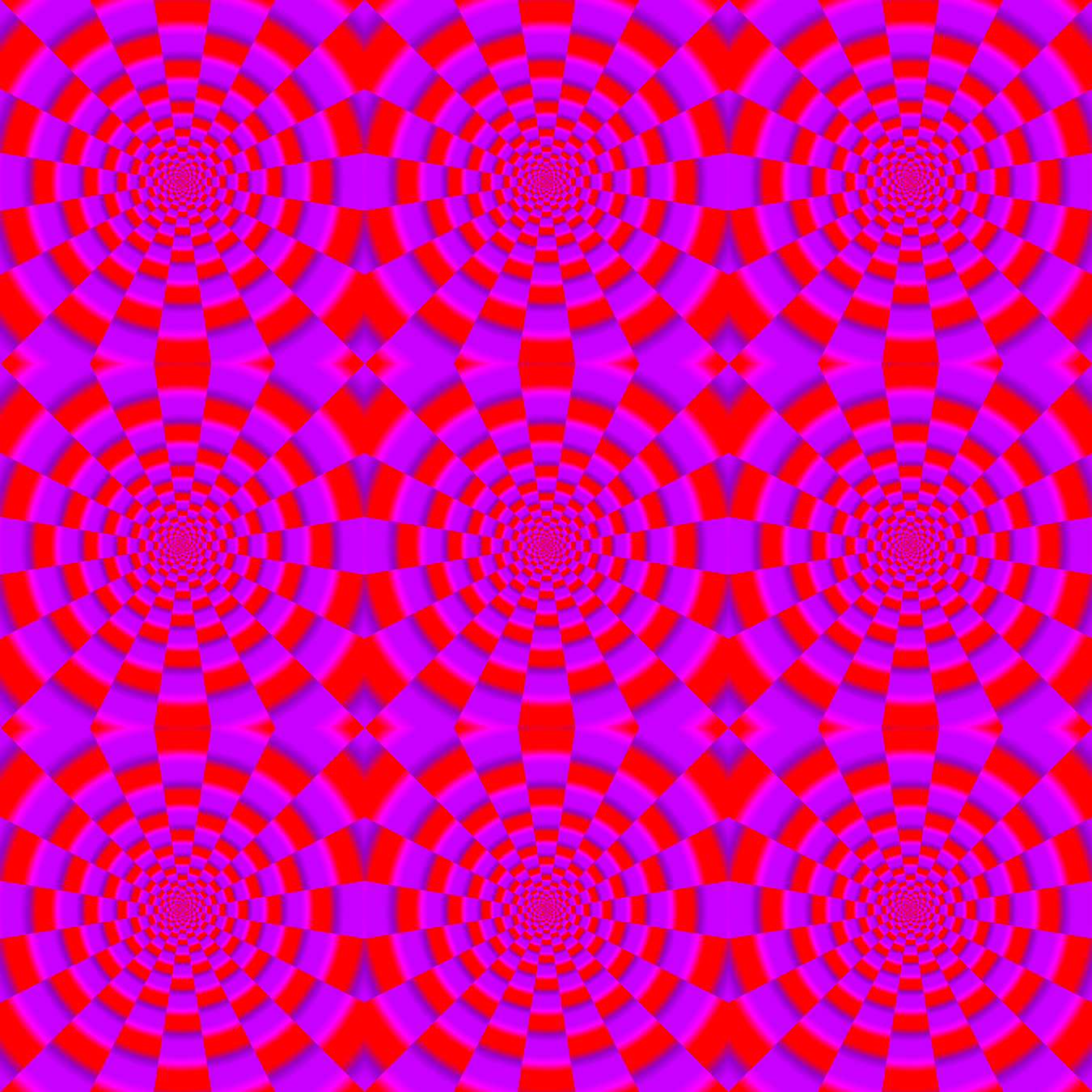
"Active volcano"
Each disk appears to expand when this image is presented on a bright PC display or in a print with a bright environment..
Copyright Akiyoshi Kitaoka 2013 (April 7)
Conclusion in advance
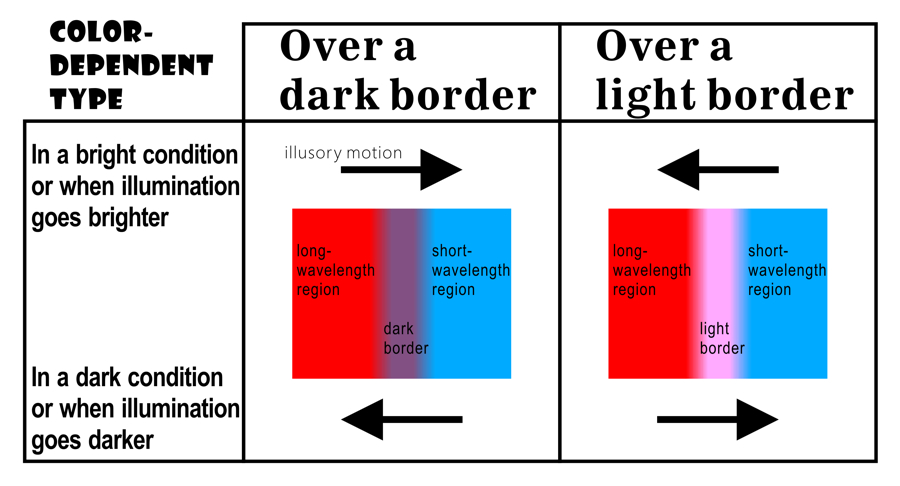
A brief history of phenomenal aspects of the Fraser-Wilcox illusion group
<Kitaoka, A. (forthcoming). The Fraser-Wilcox illusion and its extension. In Shapiro, A. and Todorovic, D. (Eds.), Oxford Compendium of Visual Illusions. Oxford University Press.>
1. Fraser and Wilcox (1979)
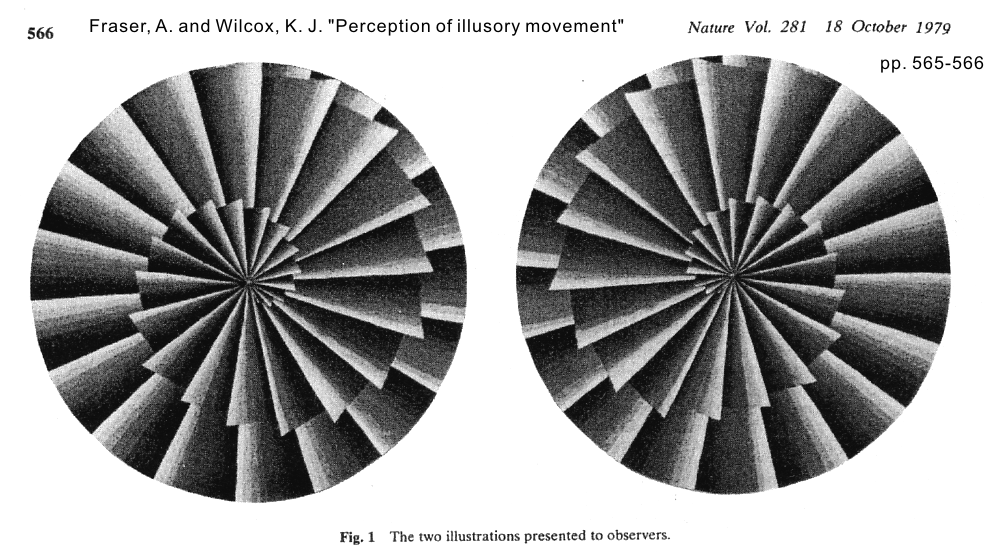
References
Fraser, A. and Wilcox, K. J. (1979). Perception of illusory movement. Nature, 281, 565-566.
Observers saw illusory motion in a stationary image which consists of repeated luminnace gradient in a saw-tooth wave form. Some reported illusory motion from dark to light along a luminance gradient, while others saw the reversal. The illusion is strong in the peripheral viewing. Fraser and Wilcox (1979) claimed that this individual difference depends on some genetic properties.
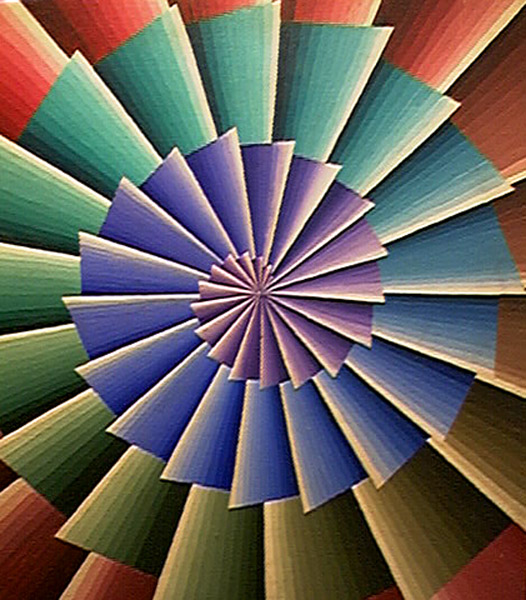
Adopted from “Alex Fraser, Geneticist and Painter”
(http://doctoralexfraser.blogspot.jp/p/spirals.html) <access August 25, 2012> (with permission from Alan Fraser)
Alex Fraser (1923-2002) was a geneticist and a painter.
2. Faubert and Herbert (1999)
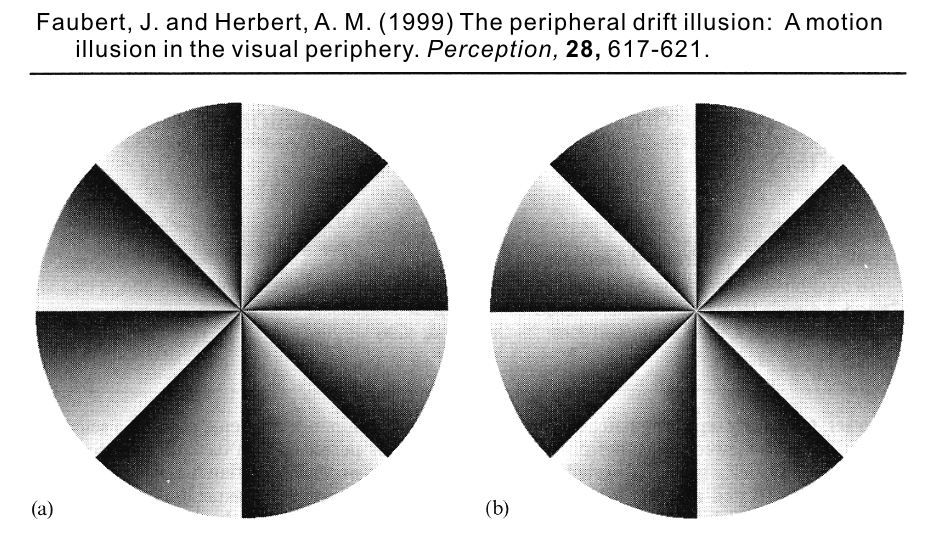
The left disk appears to rotate clockwise while the right one counterclockwise. Faubert and Herbert (1999) reported only illusory motion from dark to light along a luminance gradient. They attributed the illusory motion to the assumed time difference between responses to black and white.
References
Faubert, J. and Herbert, A. M. (1999). The peripheral drift illusion: A motion illusion in the visual periphery. Perception, 28, 617-621.
3. Naor-Raz and Sekuler (2000)
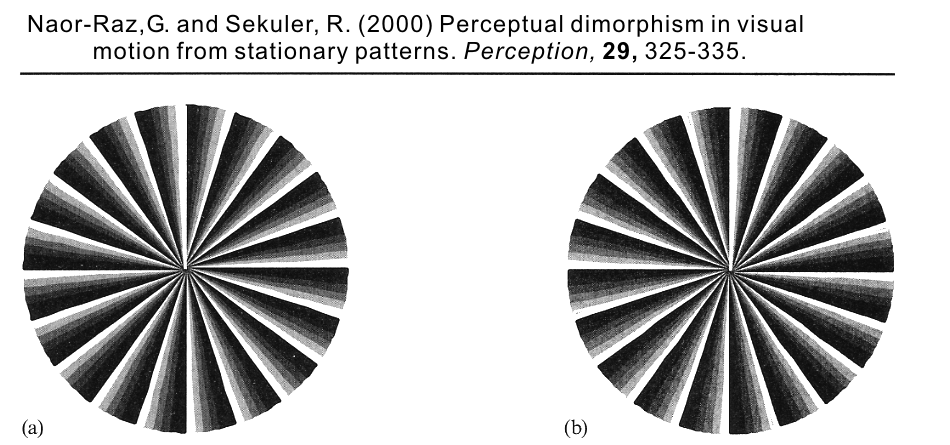
The left disk appears to rotate clockwise while the right one counterclockwise. Naor-Raz and Sekuler (2000), too, reported only illusory motion from dark to light along a luminance gradient. They revealed that the illusion magnitude is a positive, nearly linear function of contrast.
References
Naor-Raz, G. and Sekuler, R. (2000). Perceptual dimorphism in visual motion from stationary patterns. Perception, 29, 325-335.
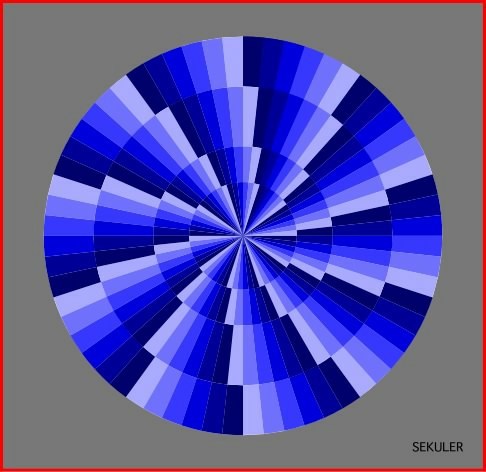
This disk appears to rotate clockwise.
This color illusion image presented by Naor-Raz and Sekuler (2000) (shown
below) might be attributable to this type.
http://www.perceptionweb.com/perception/perc0300/sekuler.jpg <access August 26, 2012>
<with permission from Robert Sekuler>
4. Kitaoka and Ashida (2003)
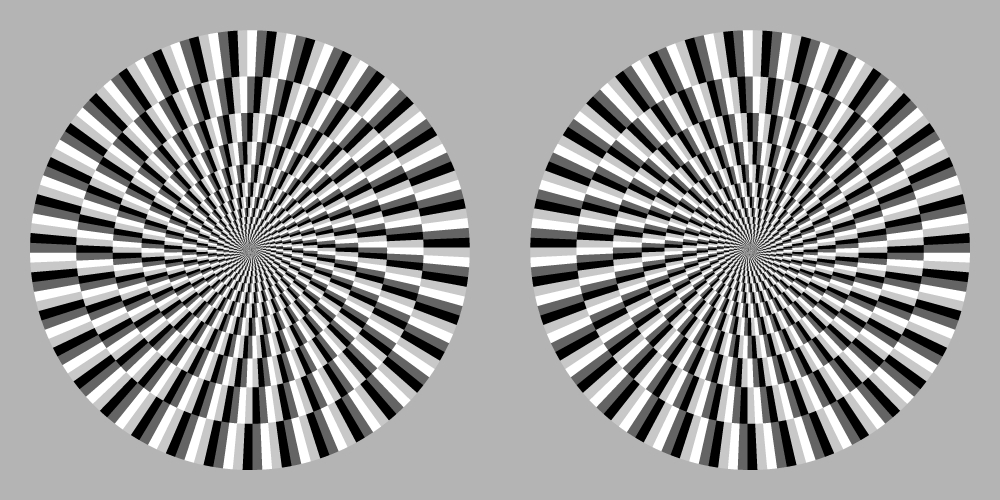
The left disk appears to rotate counterclockwise while the right one clockwise. Kitaoka and Ashida (2003) proposed that the illusory motion is strong when patterns are arranged in the following luminance order: from black, dark-gray, white, light-gray, and back to black.
References
Kitaoka, A. and Ashida, H. (2003). Phenomenal characteristics of the peripheral drift illusion. VISION (Journal of the Vision Society of Japan), 15, 261-262. PDF
5. Kitaoka (2007)
Kitaoka (2007) classified the Fraser-Wilcox illusion into Type I, IIa, IIb and III, in each of which the dark-to-light type was distinguished from the light-to-dark one.
References
Kitaoka, A. (2007) Phenomenal classification of the “optimized” Fraser-Wilcox illusion and the effect of color. Poster presentation in DemoNight, VSS2007, GWiz, Sarasota, Florida, USA, May 14, 2007.
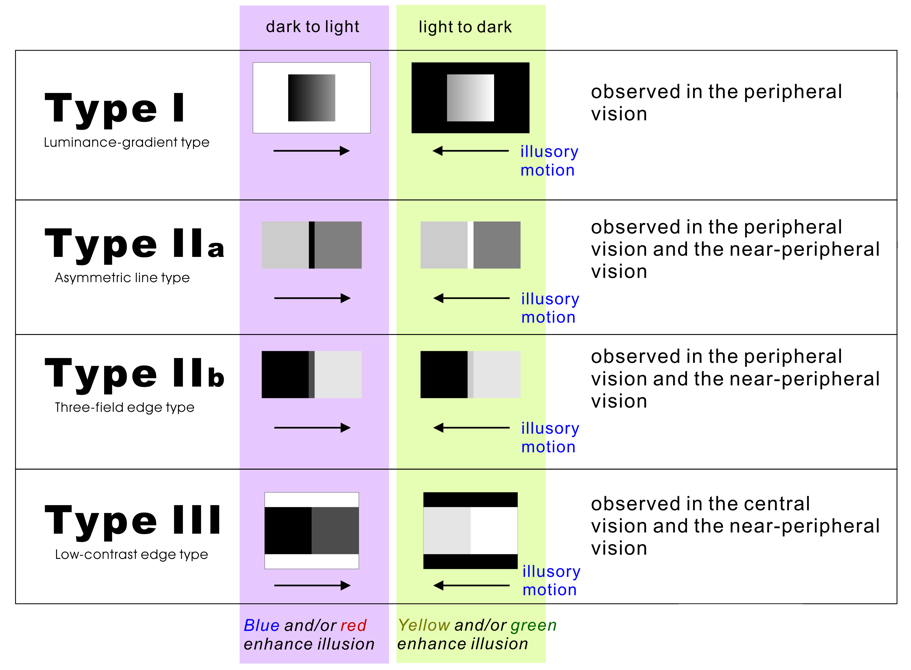
Type I
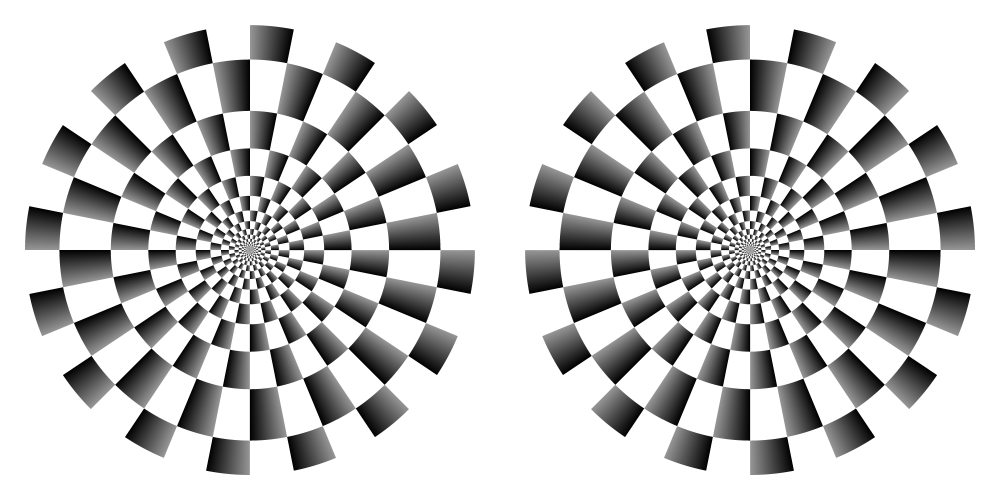
"Dark to light"
The left disk appears to rotate counterclockwise while the right one clockwise.
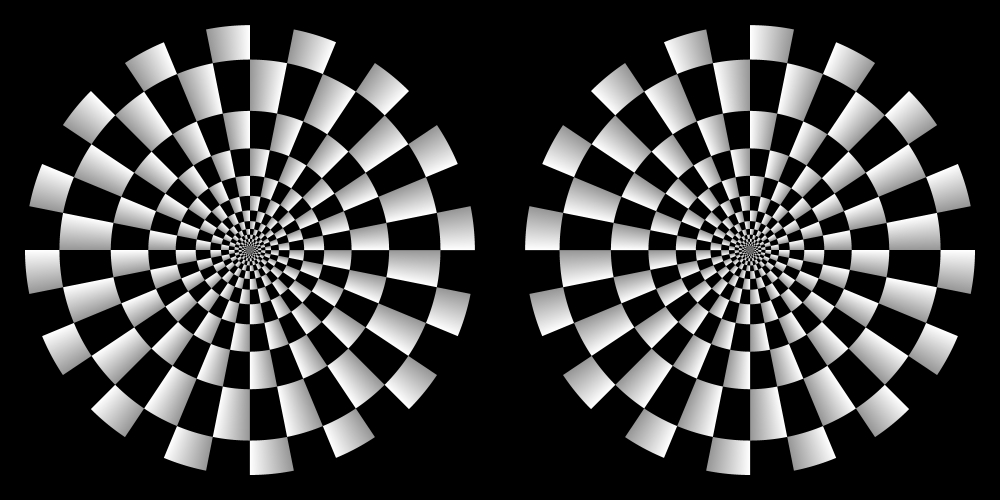
"Light to dark"
The left disk appears to rotate counterclockwise while the right one clockwise.
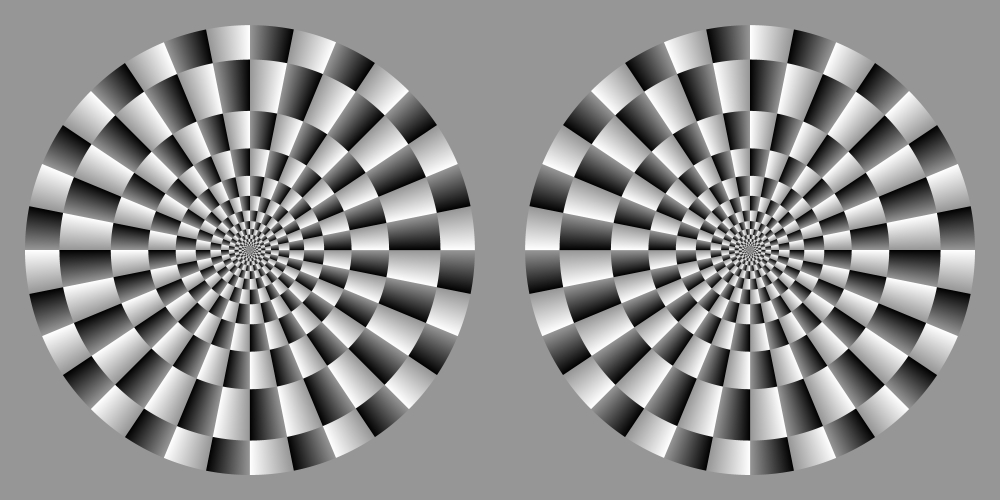
"Dark to light" and "light to dark" combined
The left disk appears to rotate counterclockwise while the right one clockwise.
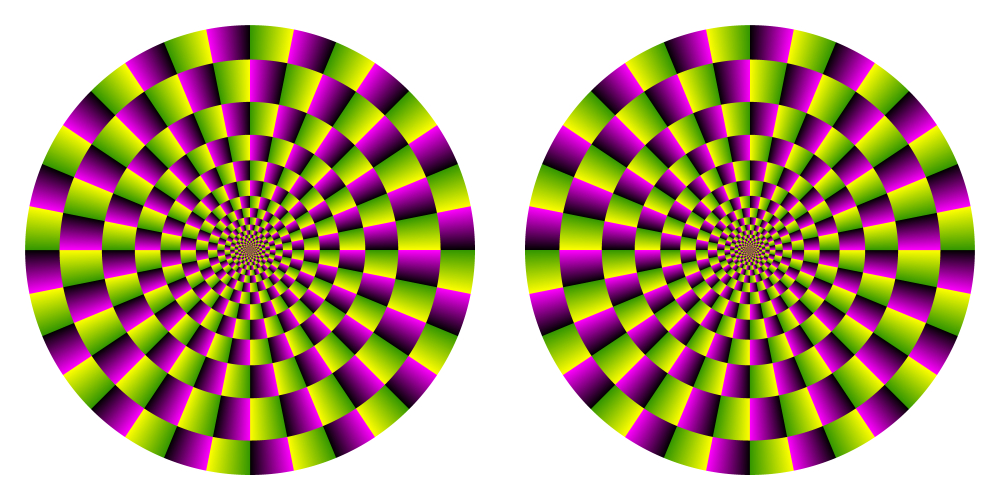
"Dark to light" and "light to dark" combined, with
color enhancement
The left disk appears to rotate counterclockwise while the right one clockwise.
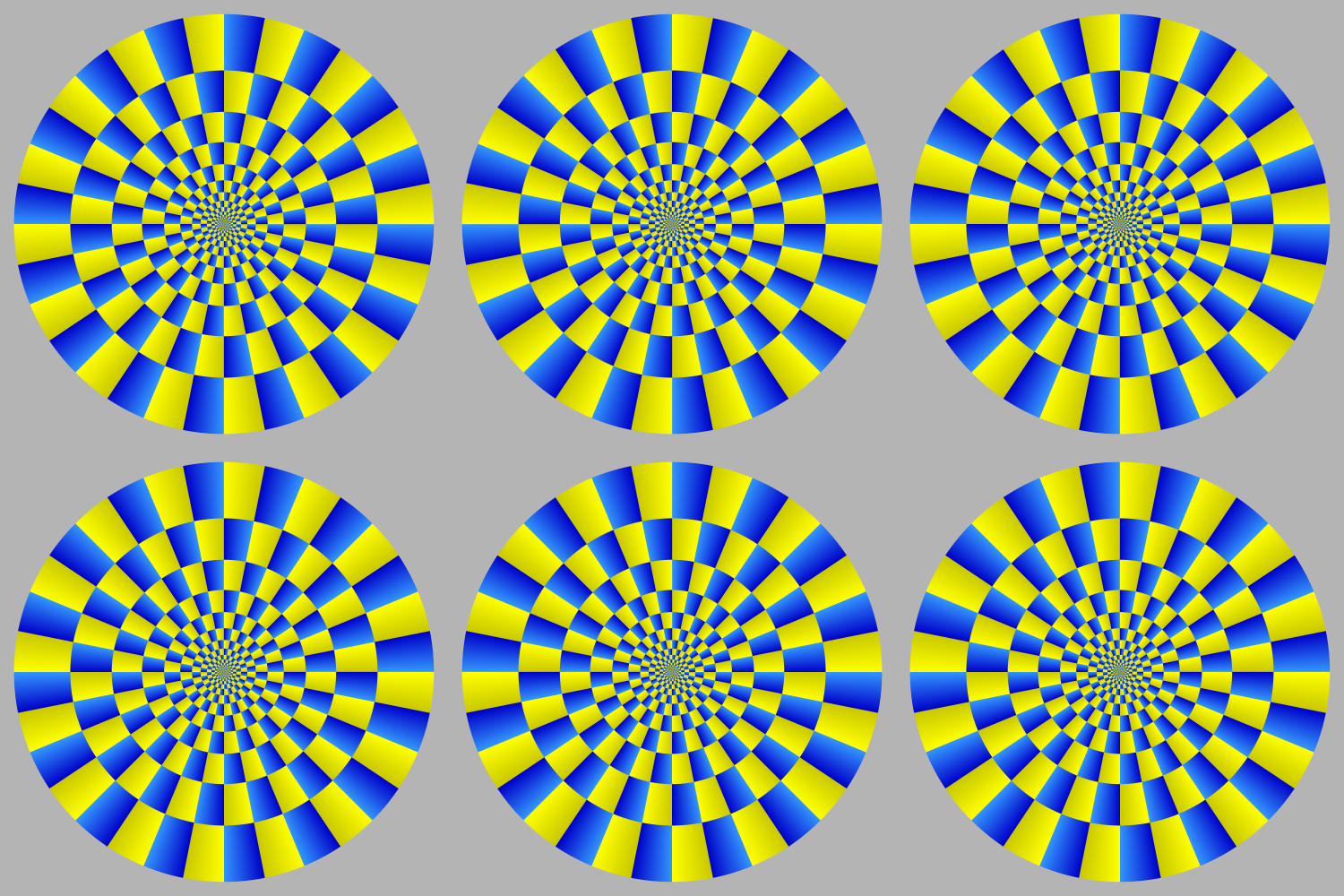
The upper-left, upper-right, and lower-middle disks appear to rotate counterclockwise
while the rest clockwise.
Type I (six disks) 1500 x 1000 (pixel)
Type I (six disks) 6000 x 4000 (pixel)
Type II
Type IIa
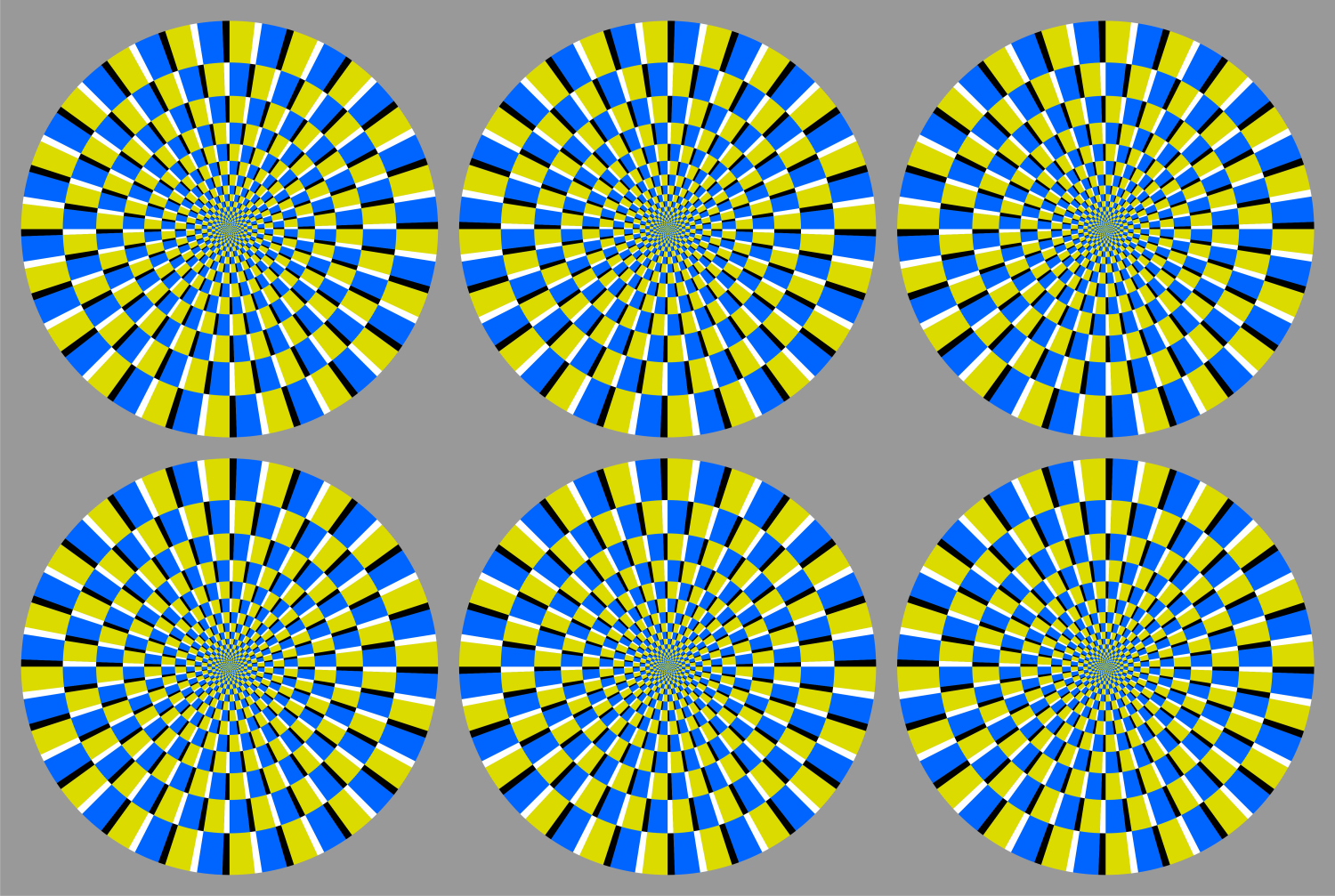
The upper-left, upper-right, and lower-middle disks appear to rotate counterclockwise
while the rest clockwise.
Type IIb
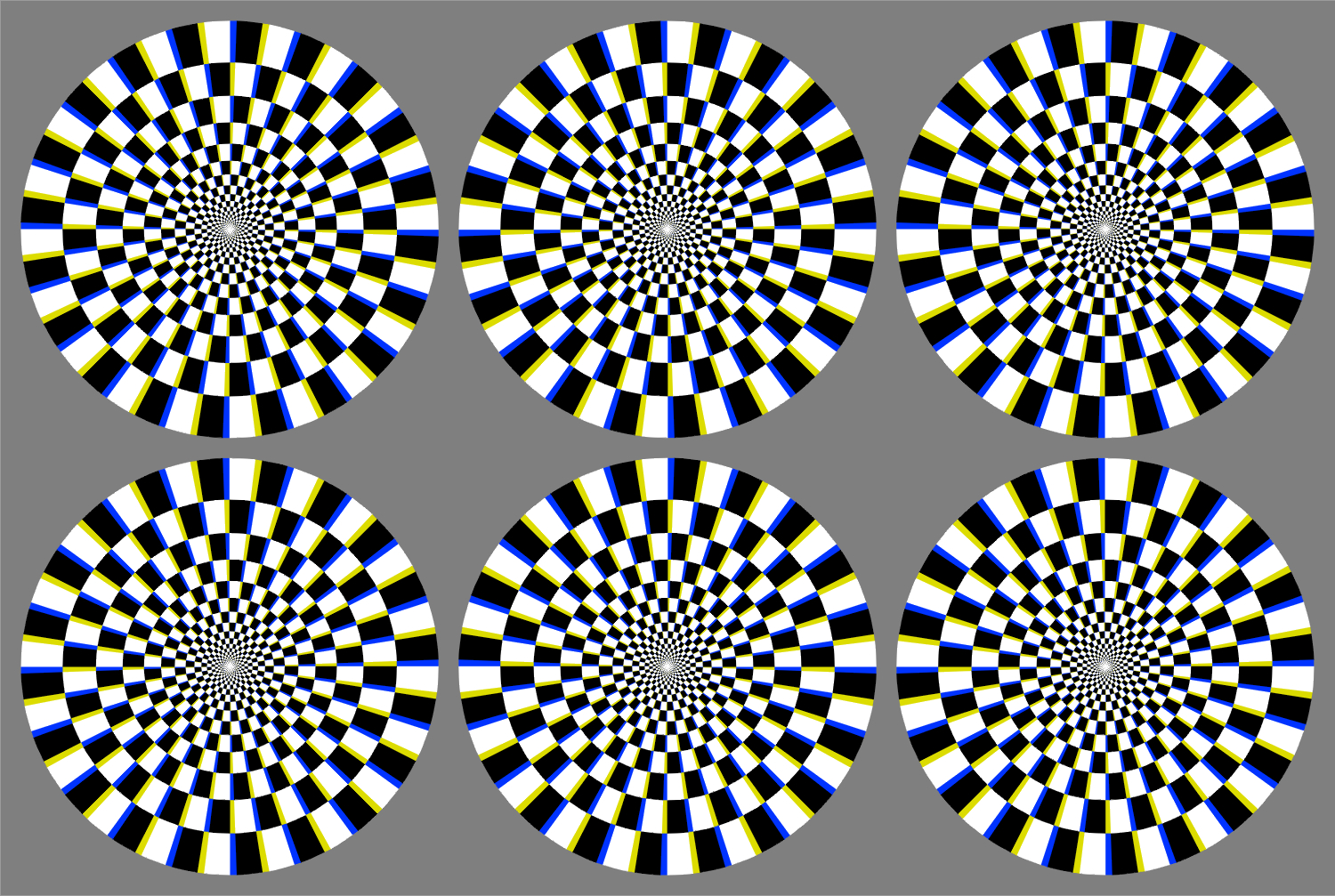
The upper-left, upper-right, and lower-middle disks appear to rotate counterclockwise while the rest clockwise.
Type IIa (six disks) 1500 x 1007 (pixel)
Type IIa (six disks) 6000 x 4031 (pixel)
Type IIb (six disks) 1500 x 1000 (pixel)
Type IIb (six disks) 6000 x 4000 (pixel)
"Rotating snakes"
(Ver. 2011)
Each disk appears to rotate.
Copyright Akiyoshi Kitaoka 2011 (January 23)
Adjusted for printing using EPSON PM-4000PX
Type III

The upper row appears to move rightward while the lower one leftward.
Type III (two rows) 1500 x 400 (pixel)
Type III (two rows) 4500 x 1200 (pixel)Type III 4500 x 1200
.jpg)
The upper-left, upper-right, and lower-middle disks appear to rotate counterclockwise
while the rest clockwise.
6. Kitaoka (2008a, b)
"Type IV" was added to the list.
References
Kitaoka, A. (2008a). Optimized Fraser-Wilcox illusions: a pictorial classification by Akiyoshi Kitaoka. Talk in Workshop No.005 "Experimental studies of anomalous motion illusions" in the 72nd Annual Convention of the Japanese Psychological Association, Hokkaido University, Sapporo, Japan, September 19, 2008. Talk
Kitaoka, A. (2008b). A new type of the optimized Fraser-Wilcox illusion in a 3D-like 2D image with highlight or shade. Journal of Three Dimensional Images (Japan), 22(4), 31-32. PDF PDF (manuscript) Presentation
Type IV
m.jpg)
The upper-left, upper-right, and lower-middle rings appear to rotate counterclockwise
while the rest clockwise.
7. Kitaoka (2008, 2010, 2012a, b)
A strongly color-dependent, "reddish" version was added to the list.
In 2008, Kitaoka found that the direction of illusory motion is “red → dark purple → purple → magenta (light red-purple) → red”, and that the illusion magnitude is strong when overall luminance contrast is low. Images of high luminance make a strong effect.
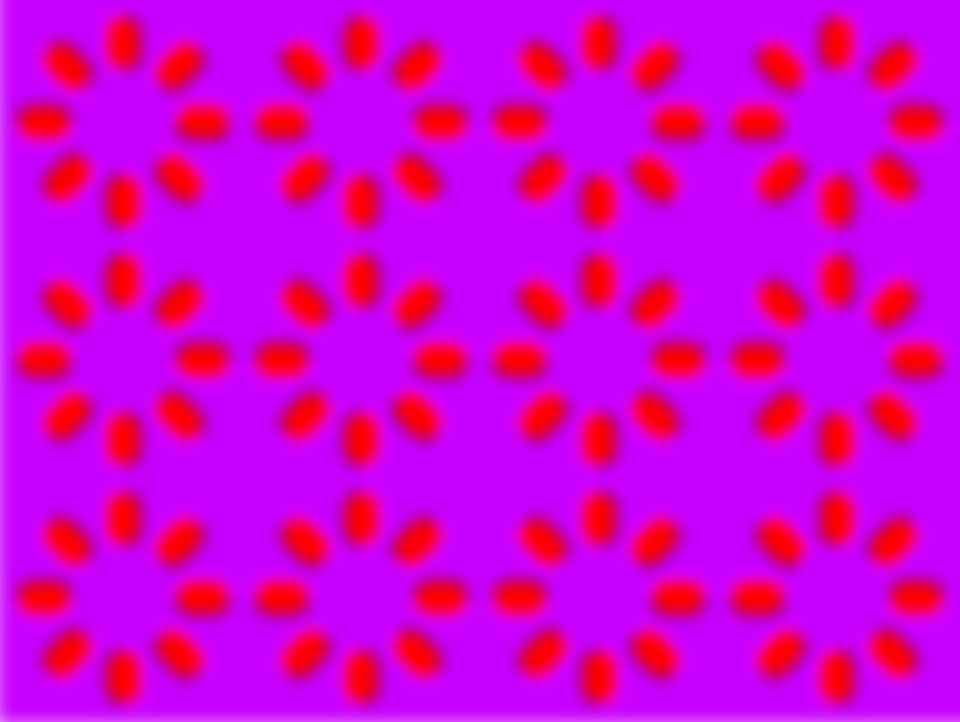
"Rotating red fruits"
Rings of fruits appear to rotate.
Copyright Akiyoshi Kitaoka 2008 (December 19)
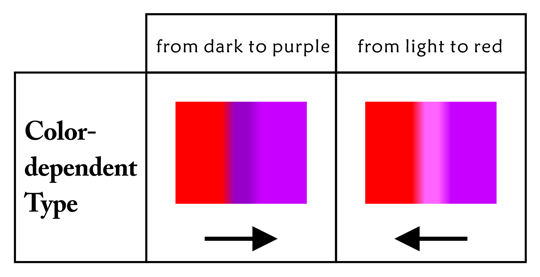
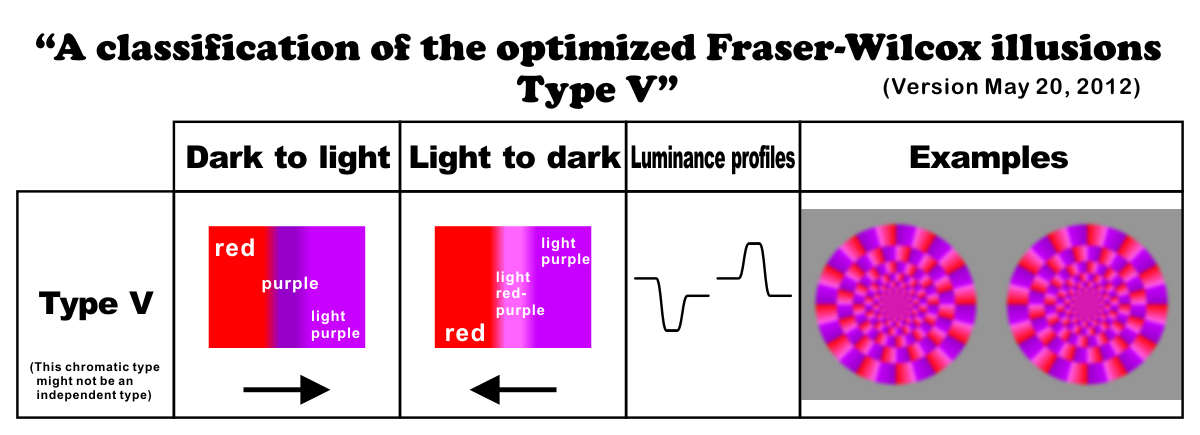
Purple » light purple » light red-purple » red » purple
References
Kitaoka, A. (2010). Introduction to visual illusion. Tokyo: Asakura-shoten (in Japanese). Book
Kitaoka, A. (2012a). Designs using the red Fraser-Wilcox illusion. Journal
of the Color Science Association of Japan, 36, Supplement, 188-189. PDF (color manuscript) Talk
Kitaoka, A. (2012b) The Fraser-Wilcox illusion and its extension. Perception 41 ECVP Abstract Supplement, page 91 (Poster September 3, 2012). Poster PDF
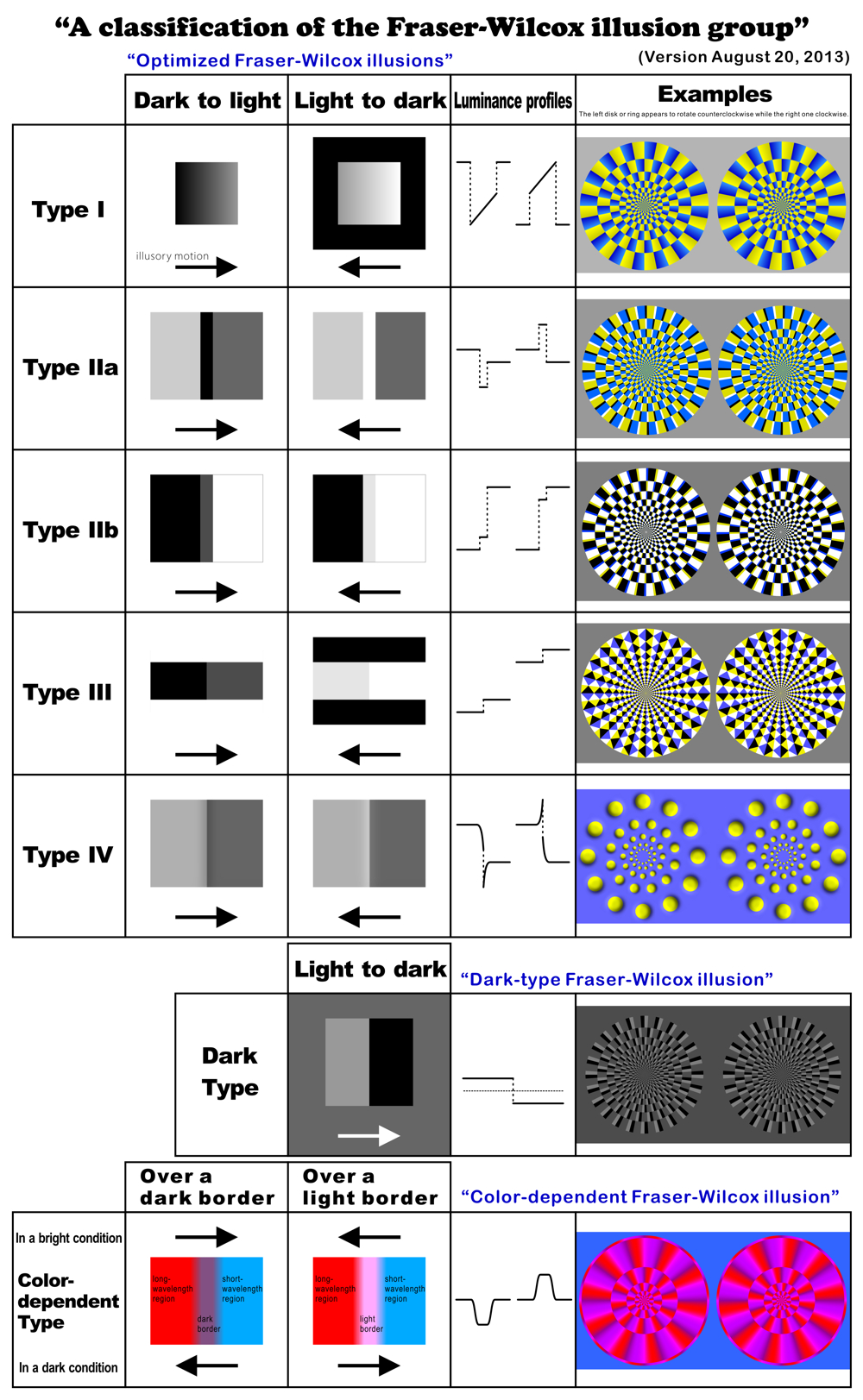
8. Kitaoka (2011)
In 2011, Kitaoka found that flickering the image increases the illusion magnitude. Blinks also work.
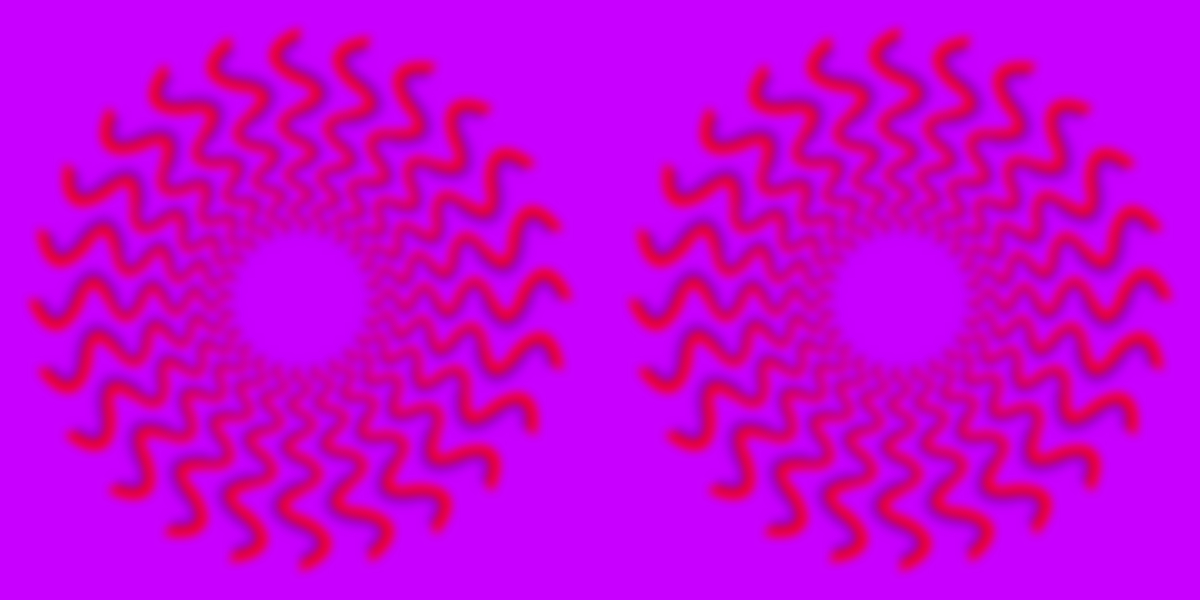
Copyright Akiyoshi Kitaoka 2012 (June 14)
Further studies on the flickering enhancement or induction (Kitaoka, 2013)
Flickering induction depends on the interaction between the stimulus and the blank.
Each disk appears to rotate clockwise during fading-in while counterclockwise during fading-out.
Copyright Akiyoshi Kitaoka 2013 (February 19)
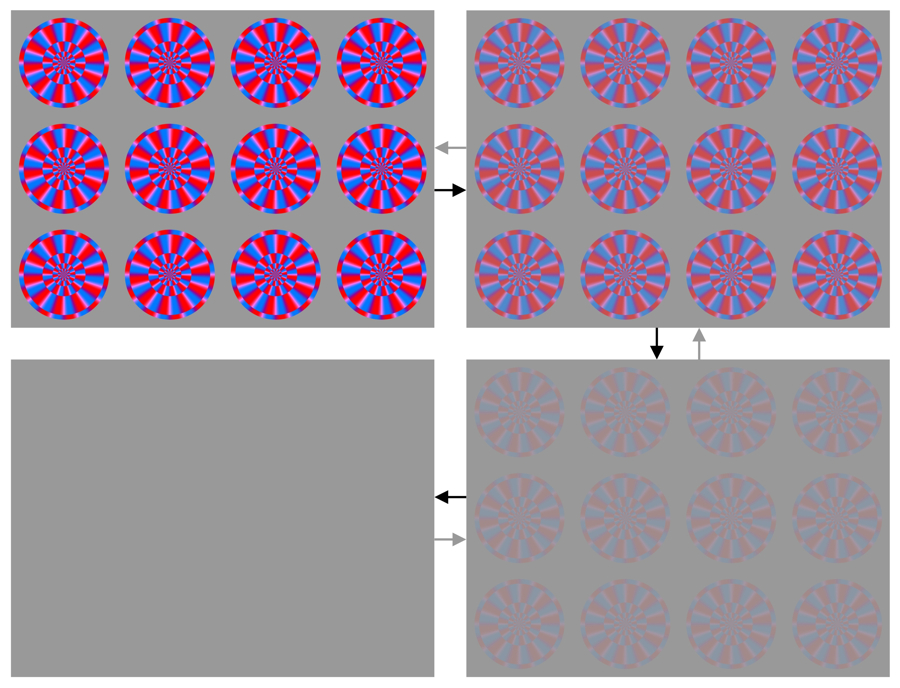
Copyright Akiyoshi Kitaoka 2013 (August 20)
Each disk appears to rotate clockwise during fading-in while counterclockwise during fading-out.
Copyright Akiyoshi Kitaoka 2013 (April 19)
Each disk appears to rotate counteclockwise during fading-in while clockwise during fading-out.
Copyright Akiyoshi Kitaoka 2013 (April 19)
Each disk appears to rotate counteclockwise during fading-in while clockwise during fading-out.
Copyright Akiyoshi Kitaoka 2013 (April 19)
Each disk appears to expand during fading-in while to contract during fading-out.
Copyright Akiyoshi Kitaoka 2013 (April 20)
9. Yanaka and Hirano (2011)
Yanaka and Hilano (2011) reported that this illusion is enhanced by mechanical shaking.
Each disk appears to rotate counterclockwise.
(Note that this movie is not their original)
References
Yanaka, K. and Hilano, T. (2011). Mechanical shaking system to enhance
"Optimized Fraser–Wilcox Illusion Type V". Perception, 40, ECVP
Abstract Supplement, page 171.
10. Yanaka (2012)
Yanaka (2012) reported that this illusion is enhanced by viewing images under dark illumination.
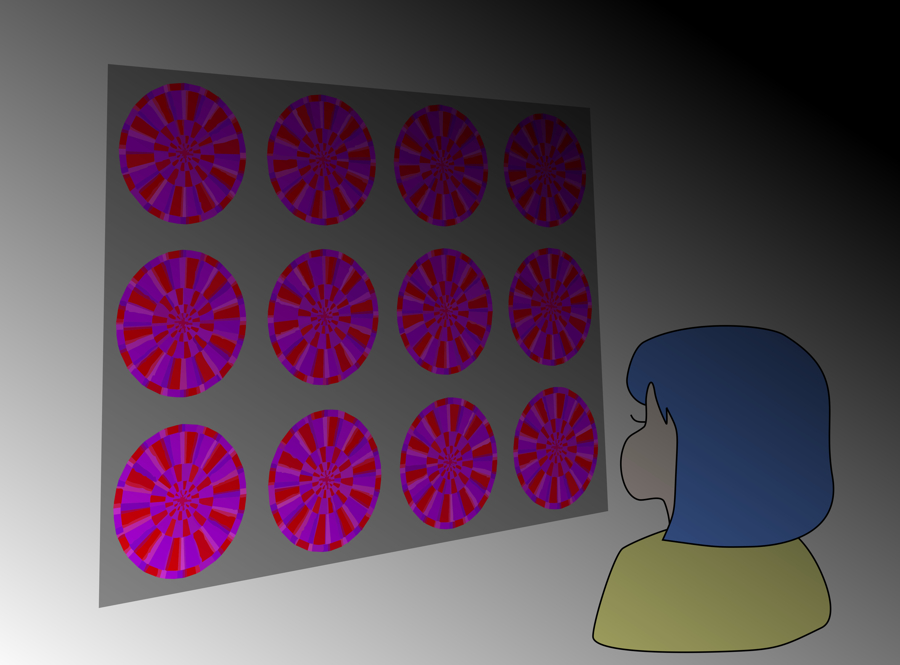
References
Yanaka, K. (2012). Enhancement of the optimized Fraser-Wilcox illusion Type V by swinging the image. Talk in the 5th Illusion Workshop, Meiji University, Tokyo, Japan, September 18, 2012.
11. Kitaoka (2013)
In 2013, Kitaoka (ECVP2013) found that Yanaka’s darkening enhancement is accompanied by a reversal of illusion: i.e., the direction under dark condition is “red → magenta (light red-purple) → purple → dark purple → red”.
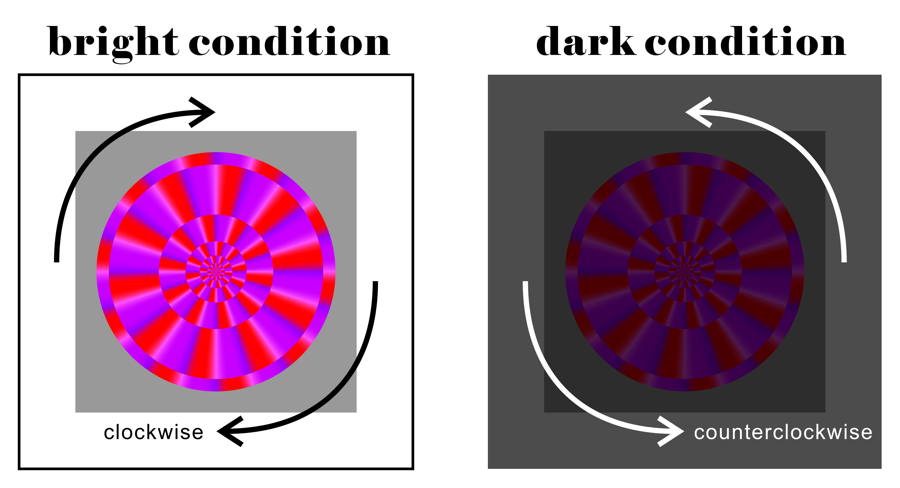
References
Kitaoka, A. (2013). Invisible color and visible color: Mystery of color the brain feels. Talk in the Shizuoka Science Museum Ru-Ku-Ru, Shizuoka, Japan, January 13, 2013. Talk
12. Kitaoka (2013)
In 2013, Kitaoka (ECVP2013) found that combination of a long wavelength color and a short one makes the illusions.
Illusory motion depending on the combination of colors


"Rotating red-and-purple disks"
Each disk appears to rotate clockwise on a bright display, while it appears to rotate counterclockwise with a printed image under dark illumination.
Copyright Akiyoshi Kitaoka 2013 (February 6)
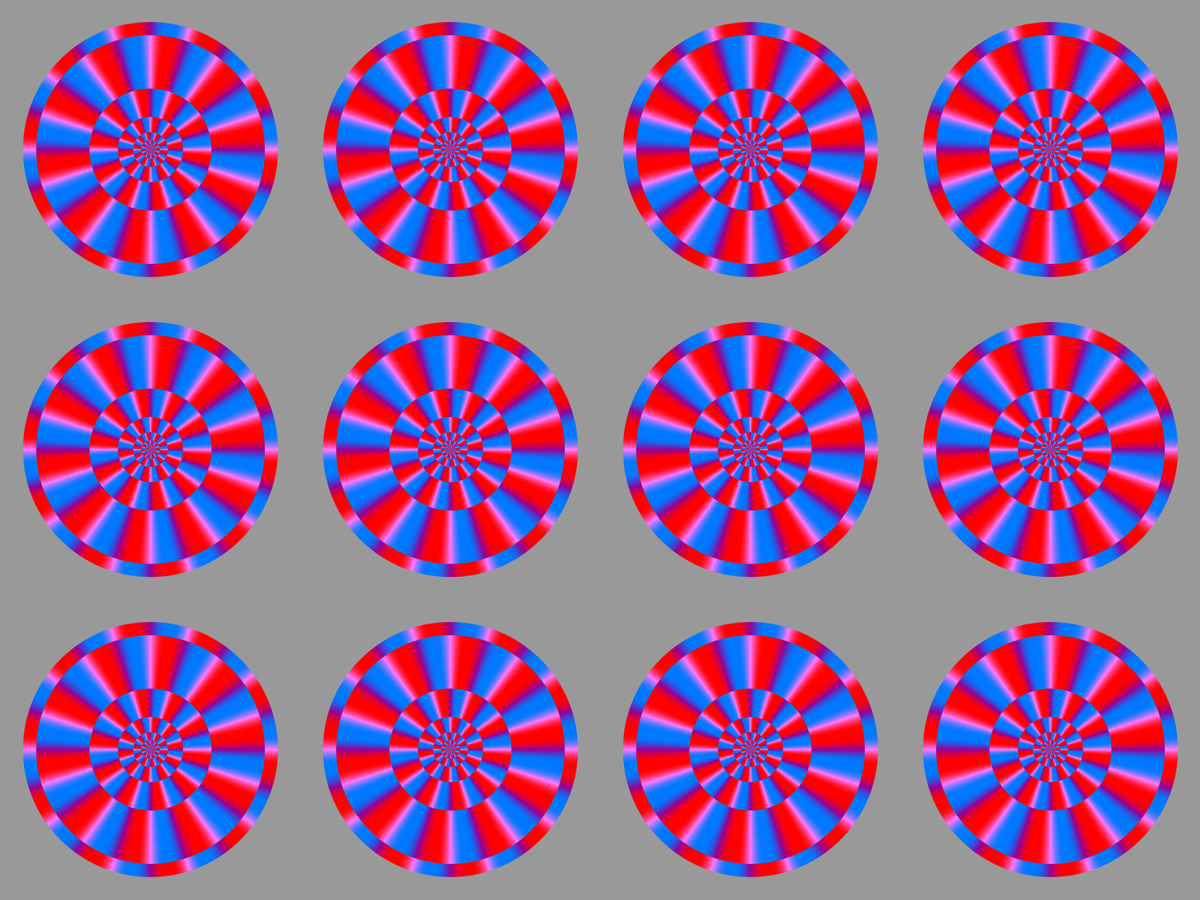
"Rotating red-and-cyan disks"
Each disk appears to rotate clockwise on a bright display, while it appears to rotate counterclockwise with a printed image under dark illumination.
Copyright Akiyoshi Kitaoka 2013 (February 1)

"Rotating red-and-cyan disks 2"
Each disk appears to rotate clockwise on a bright display, while it appears to rotate counterclockwise with a printed image under dark illumination.
Copyright Akiyoshi Kitaoka 2013 (February 6)
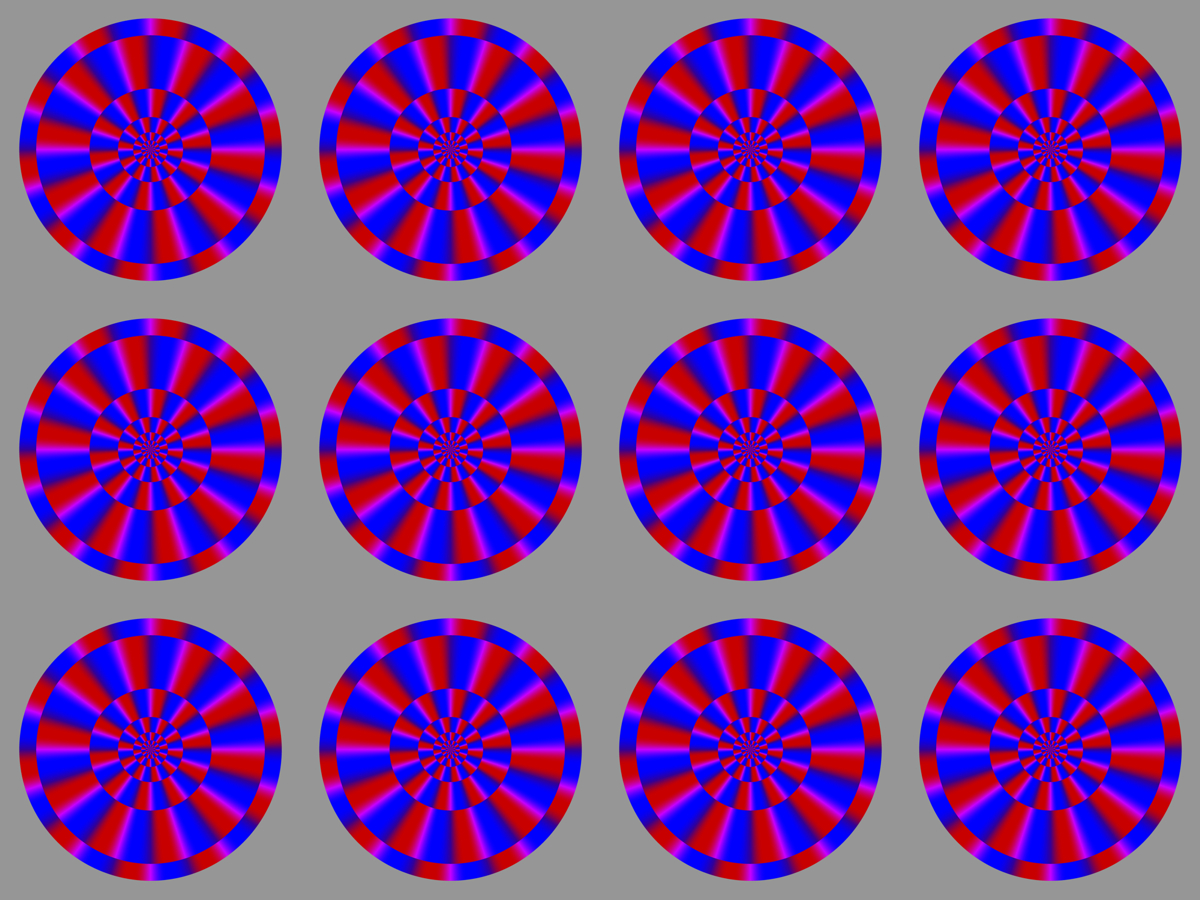
"Rotating red-and-blue disks"
Each disk appears to rotate clockwise on a bright display, while it appears to rotate counterclockwise with a printed image under dark illumination.
Copyright Akiyoshi Kitaoka 2013 (January 29)
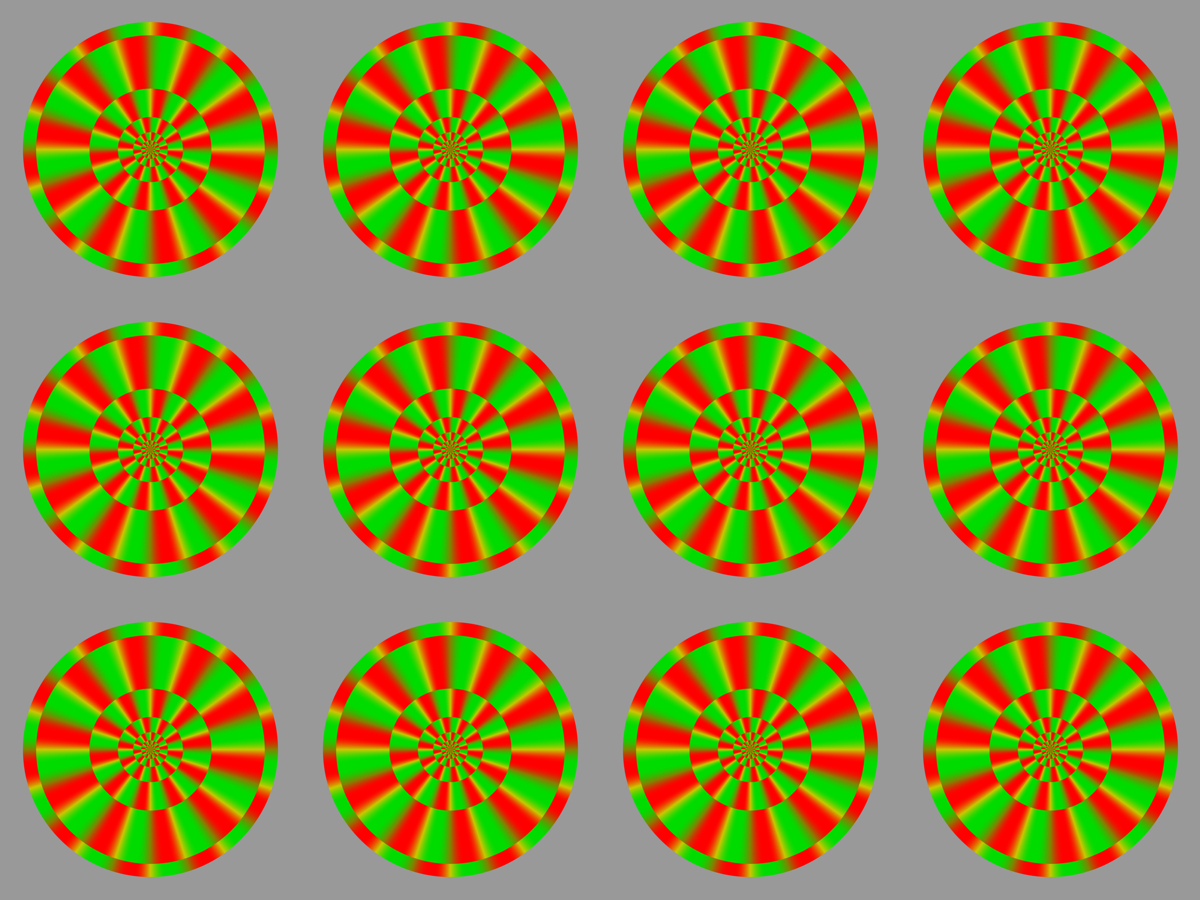
"Rotating red-and-green disks"
Each disk appears to rotate clockwise on a bright display, while it appears to rotate counterclockwise with a printed image under dark illumination.
Copyright Akiyoshi Kitaoka 2013 (January 29)
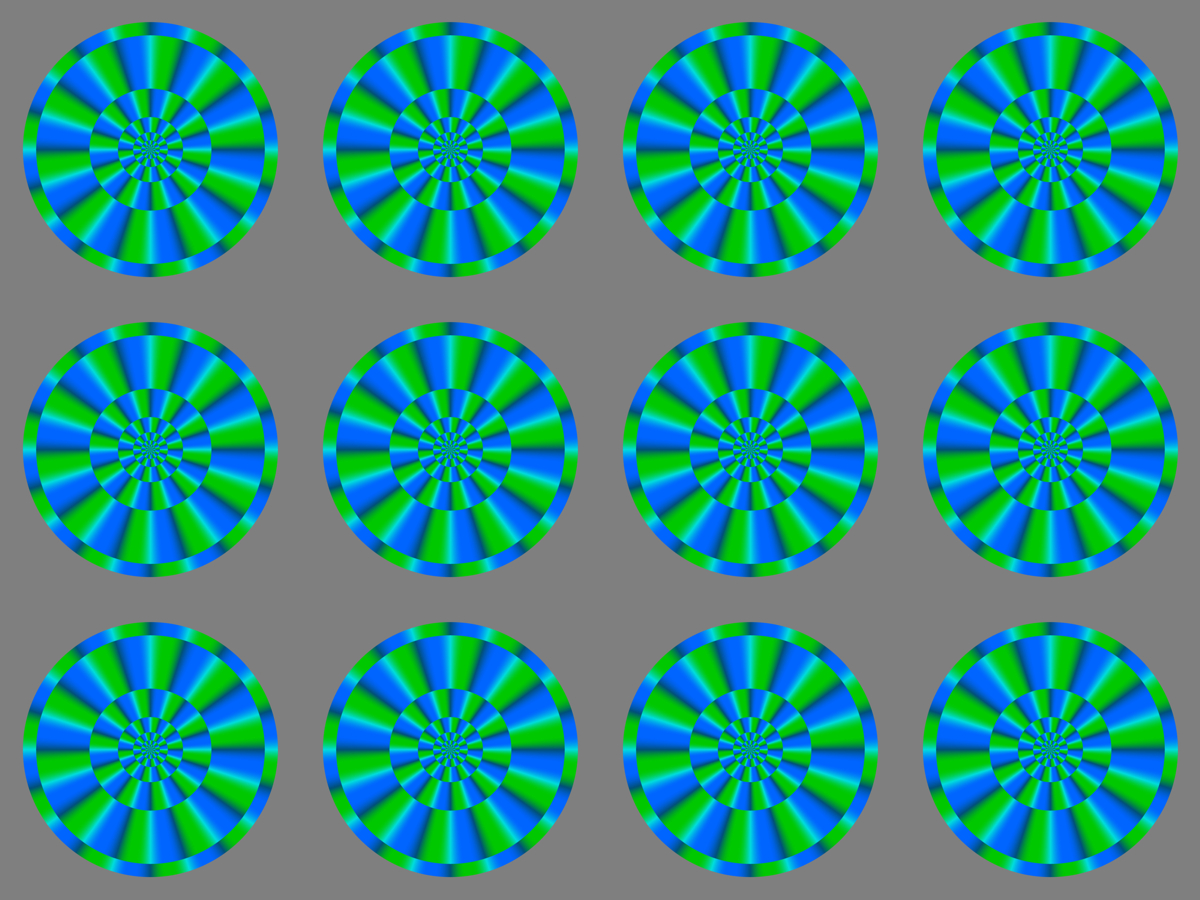
"Rotating blue-and-green disks"
Each disk appears to rotate clockwise on a bright display, while it slightly appears to rotate counterclockwise with a printed image under dark illumination.
Copyright Akiyoshi Kitaoka 2013 (February 6)
13. Kitaoka (2013)
In 2013, Kitaoka (ECVP2013) found that increasing or decreasing illumination makes the illusions.
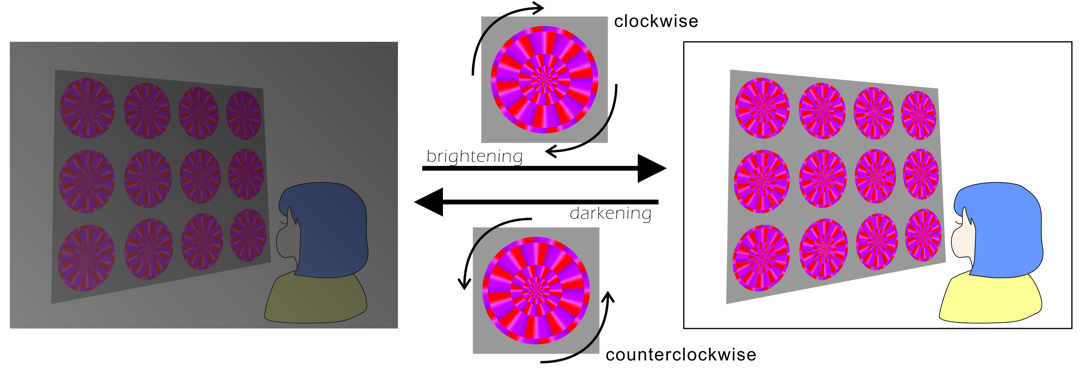
14. Kitaoka (2013)
It is suggested that this ‘luminance change-induced’ motion* might generate
the color-dependent Fraser-Wilcox illusion, being triggered by saccades,
blinks, flickering or shaking the images.
*The luminance change-induced’ motion includes the reverse phi phenomenon
(Anstis, 1970; Anstis and Rogers, 1975) and the phenomenal phenomena (Gregory
and Heard, 1983). Directions of illusory motion depending on the changes
of luminance are shown in the right (Kitaoka, 2006).
References
Anstis S M, 1970 “Phi movement as a subtraction process” Vision Research 10 1411-1430
Anstis S M, Rogers B J, 1975 “Illusory reversal of visual depth and movement
during changes of contrast” Vision Research 15 957-961
Gregory R L, Heard P F, 1983 “Visual dissociations of movement, position,
and stereo depth: some phenomenal phenomena” Quarterly Journal of Experimental
Psychology 35A 217-237
Kitaoka, A. (2006). Configurational coincidence among six phenomena: A
comment on van Lier and Csathó (2006). Perception,
35, 799-806. animations --- PDF
"Rotating gray-scale disks (movie)"
Disks appear to rotate clockwise or counterclockwise.
Copyright Akiyoshi Kitaoka 2013 (February 15)
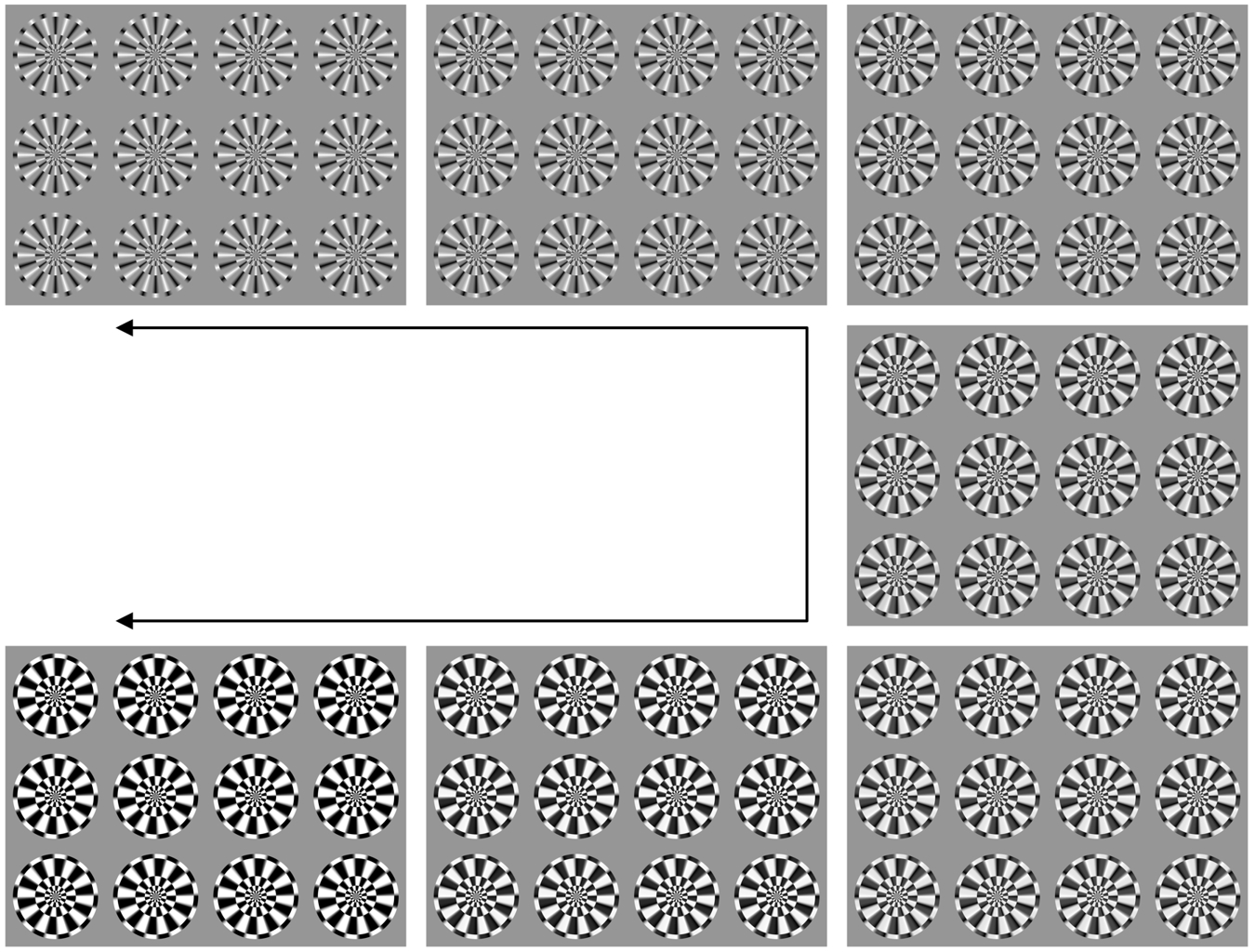
Configurational coincidence among six phenomena: A comment to van Lier
and Csathó (2006)
Kitaoka, A. (2006). Configurational coincidence among six phenomena: A comment on van Lier and Csathó (2006). Perception, 35, 799-806. animations --- PDF
Adobe Flash Player is necessary to play animations on this page.
Animation 1
Reversed phi movement (Anstis and Rogers 1975). There are four rectangles, each of which is flanked by thin lines that are dark or light. When the luminance of the rectangles decreases and that of the background increases accordingly, the upper two appear to converge in motion while the lower two appear to go apart in motion. On the other hand, when the luminance of the rectangles increases and that of the background decreases accordingly, the upper two appear to go apart in motion while the lower two appear to approach each other in motion. In sum, the direction of apparent motion is from the dark flank to the neighboring part that goes darkening or from the light flank to the neighboring part that goes brightening. Although the rectangles are aligned vertically, the apparent positional displacement occurs in the opposite direction to motion. If observers cross-fuse (uncross-fuse) the right and left rectangles, the upper rectangle appears to be in front of (behind) the lower one when they are dark.
Animation 2
The illusory motion investigated by Gregory and Heard (1983). This appearance is quite similar to Animation 1. The only configurational difference from the reversed phi movement is that the luminance of the rectangles is constant.
Animation 3
The illusory motion mentioned by Gregory and Heard (1983), in which the luminance of the rectangles dynamically changes while that of the surround is constant. This appearance is quite similar to Animations 1 and 2.
Animation 4
Phi movement (Anstis and Rogers 1975). For panel (a), dark stationary rectangles are placed on a bright stationary background. When the luminance of the right flank of each rectangle increases and that of the left flank decreases, the rectangle appears to shift leftward in motion as well as in position. Conversely, the luminance of the right flank decreases and that of the left flank increases, the rectangle appears to shift rightward in motion and position. If observers cross-fuse (uncross-fuse) the right and left rectangles, the fused rectangle appears to be in front (behind) when the right flank of the right rectangle are dark and the left flank of the left rectangle are dark. For panel (b), bright rectangles are placed on a dark background. In this case, phenomena are the reversal of panel (a).
(a) (b)
(a) Flash(swf) --- QuickTime(mov)
(b) Flash(swf) --- QuickTime(mov)
Animation 5
Consistency between the reversed phi movement and stereopsis (Anstis and Rogers 1975). In this animation, there are two phases in motion, in which the upper-left and the lower-right rectangles are one eighth phase in advance of the upper-right and the lower-left rectangles. For example, when the luminance of the rectangles increases, the upper-left rectangle appear to go leftward followed by the upper-right one, while the lower-right rectangle appear to go leftward followed by the lower-left one. In this period, the cross-fused (uncross-fused) upper rectangle appears to be in front (behind) as compared with the cross-fused (uncross-fused) lower rectangle.
Animation 6
Consistency between the apparent motion and Café-Wall-like tilt illusions (van Lier and Csathó 2005). According to dynamic changes in luminance gradient, the flanks of the rectangle appears to tilt dynamically. (a) The luminance gradient given to both flanks is dynamically changed while the dark-gray rectangle and the light-gray background are stationary. The dark part of the gradient appears to shift outward in motion and position while the bright part appears to shift inward in motion and position. This distortion agrees with the tilt illusion. (b) The luminance gradient given to the rectangle is dynamically changed while the dark flanks and the gray background are stationary. At the dark part of the gradient, the neighboring part of flanks appears to shift inward in motion and position, while at the bright part of the gradient, the neighboring part of flanks appears to shift outward in motion and position. This distortion agrees with the tilt illusion.
(a) (b)
(a) Flash(swf) --- QuickTime(mov)
(b) Flash(swf) --- QuickTime(mov)
Animation 7
Inconsistency between the apparent motion and Café-Wall-like tilt illusions. According to dynamic changes in homogenous areas, the flanks of the rectangle appears to tilt dynamically. (a) The luminance of the homogeneous rectangle is dynamically changed while the flanks with luminance gradient and the gray background are stationary. The darkening rectangle appears to attract the dark parts of the flanks inward in motion while the brightening rectangles appears to attract the light parts of the flanks inward in motion. This distortion disagrees with the tilt illusion. (b) The luminance of the homogeneous flanks is dynamically changed while the rectangle with luminance gradient and the gray background are stationary. At the dark part of the gradient, brightening flanks appears to shift inward in motion, while at the bright part of the gradient, darkening flanks appears to shift inward in motion. This distortion disagrees with the tilt illusion
(a) (b)
(a) Flash(swf) --- QuickTime(mov)
(b) Flash(swf) --- QuickTime(mov)
Animation 8
Demonstration of the apparent motion in the three elemental spatio-temporal configurations (Figure 6). The behaviors in (a), (b) and (g) are summarized in Figure 6a (off-center line-type configuration); those in (c), (d) and (h) are in Figure 6b (on-center line-type configuration); and those in (e), (f) and (i) are summarized in Figure 6c (edge-type configuration). For further explanations, see the text.
(a) (b)
(a) Flash(swf) --- Quicklime(mov)
(b) Flash(swf) --- QuickTime(mov)
(c) (d)
(c) Flash(swf) --- QuickTime(mov)
(d) Flash(swf) --- QuickTime(mov)
(e) (f)
(e) Flash(swf) --- QuickTime(mov)
(f) Flash(swf) --- QuickTime(mov)
(g) (h) (i)
(g) Flash(swf) --- QuickTime(mov)
(h) Flash(swf) --- QuickTime(mov)
(i) Flash(swf) --- QuickTime(mov)
Directions of illusory motion depending on changes of luminance in each
area
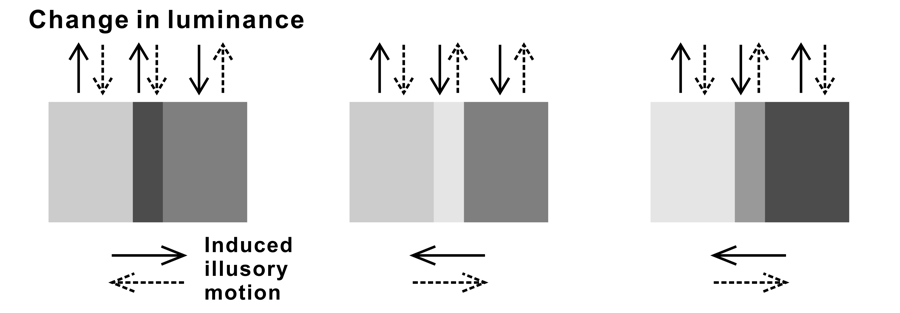

Involvement of the Purkinje shift is suggested. Short wavelength color
appears to be relatively bright under a dark condition. Decreasing illumination
makes short wavelength color relatively bright. This might induce the luminance
change-dependent motion illusion and show the color-dependent Fraser-Wilcox
illusion.
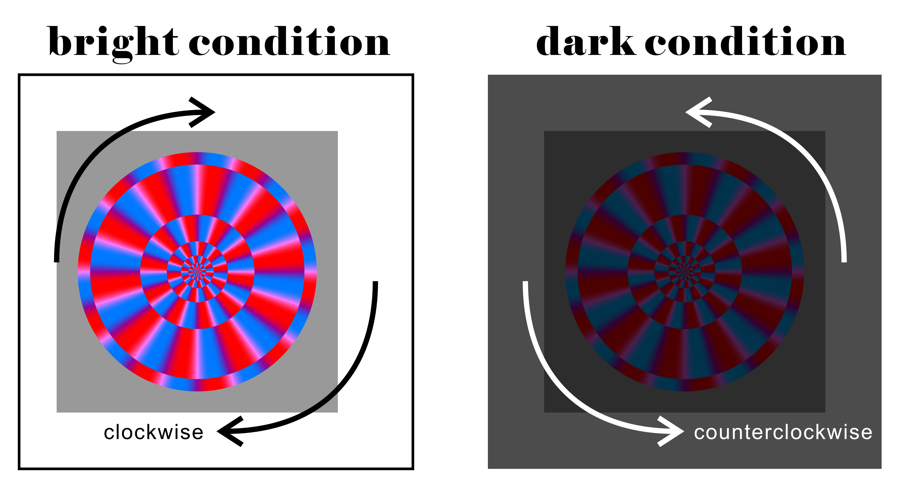
現時点(2013年9月29日)における北岡の妄想
| 錯視の種類 | 想定される輝度変調の発生部位 |
| 色依存のフレーザー・ウィルコックス錯視の暗い時の逆錯視 | 杆体 |
| 色依存のフレーザー・ウィルコックス錯視の明るい時の正錯視の急速相 | 杆体? |
| 色依存のフレーザー・ウィルコックス錯視の明るい時の正錯視の緩徐相 | ipRGC |
| 最適化型フレーザー・ウィルコックス錯視 タイプI, II, III, IV | 杆体 + ipRGC? |
| 最適化型フレーザー・ウィルコックス錯視 ダークタイプ | ipRGC? |
| 中心ドリフト錯視 | 錐体 + ipRGC? |
| 矢印ドリフト錯視 | 錐体 + ipRGC? |
続いて、輝度変調依存性の運動錯視が発生して動いて見える、と考える。

北岡明佳氏(立命館大学文学部心理学専攻教授)
寺田努氏(神戸大学大学院工学研究科准教授)
平井重行(京都産業大学コンピュータ理工学部准教授)
北岡氏、寺田氏、平井、田中宏喜(京都産業大学コンピュータ理工学部准教授)
上田博唯(京都産業大学コンピュータ理工学部客員教授)
脳の働きを計測する機器が目覚ましい発展を果たし、この数年で脳科学という研究分野がとても身近な存在になりました。
本学でも脳科学に取り組む複数の研究室が活躍中です。また、生活の中のあらゆる場所にコンピュータが存在して日常生活をサポートしてくれるようになるユ ビキタスコンピューティング技術の普及も目前に迫っており、この分野でも本学の複数の研究室が精力的に取り組んでいます。
このたび、これらの学術・技術分野と深い関係のある錯視の研究とウェアラブルコンピュータの研究で活躍中の二人の先生をお招きして、コンピュータ理工学部のシンポジウムを開催します。
錯視は人間の脳の働きの不思議の一つであり、これを解明することで色々な脳の働きの謎を解く手がかりが得られると期待されています。
ウェアラブルとは身につけるという意味ですが、どこにでもあるという意味のユビキタスと対をなす言葉で、今年大きな話題となったグーグルグラスに代表さ れる眼鏡タイプのカメラやディスプレイなどと一緒に身につけるコンピュータなどを総称する言葉です。我々の生活をより豊かなものにする技術として期待され ています。
これらの分野の研究者のコラボレーションによって、どんな未来を切り開いて行くことができるのか、そういうことをそれぞれの思いを込めて語り合う場にしたいと考えています。